
The Project Gutenberg EBook of The Tomato, by Paul Work This eBook is for the use of anyone anywhere at no cost and with almost no restrictions whatsoever. You may copy it, give it away or re-use it under the terms of the Project Gutenberg License included with this eBook or online at www.gutenberg.org Title: The Tomato Author: Paul Work Release Date: November 18, 2011 [EBook #38051] Language: English Character set encoding: UTF-8 *** START OF THIS PROJECT GUTENBERG EBOOK THE TOMATO *** Produced by Charlene Taylor, Betsie Bush, Scanned by Ray Bush and the Online Distributed Proofreading Team at http://www.pgdp.net
Professor of Vegetable Crops, Cornell University
Editor of Market Growers Journal

This book or any part thereof, may not be reproduced without permission of the publishers, except by a reviewer who wishes to quote brief passages in connection with a review written for inclusion in a magazine or newspaper. |
Copyright Under the Articles of the Copyright Convention
of the Pan American Republics and the
United States. August 11, 1910
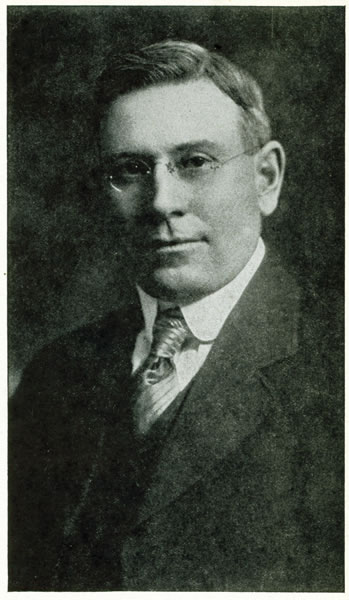 FREDERICK J. PRITCHARD
FREDERICK J. PRITCHARD| CHAPTER | PAGE | |
| Introduction | 11 | |
| I. | The Tomato is a Great Food and Crop Plant | 13 |
| II. | Choose the Soil and Feed the Plant | 25 |
| III. | The Best in Seed is None too Good | 38 |
| IV. | Strong Plants for Early Maturity and Heavy Crop | 53 |
| V. | Good Culture Favors Good Returns | 71 |
| VI. | To Train Them Up or Let Them Spread | 79 |
| VII. | The Eternal Battle with Insects and Diseases | 85 |
| VIII. | Skillful Selling Crowns the Enterprise | 93 |
| IX. | Operating in the Red or in the Black | 116 |
| References | 119 | |
| Index | 133 | |
Why should there be a book on tomatoes? The world is full of bulletins of experiment stations, of articles in periodicals and of general books on vegetables which include discussion of tomatoes.
An incomplete set of tomato bulletins includes over 350 documents. Many of these are no longer available. Many are of no great value but contribute this or that small item.
The task of a book like this is to offer between two covers, a summary of what seem the most significant facts and opinions about the third most important vegetable crop in the United States.
The tomato is one of the most rewarding crops for the home garden. A little space yields heavily, from half a peck to a peck per plant without difficulty. It grows well practically everywhere in the States, affording high nutritional values whether used fresh or canned. And people do like tomatoes, whether as salad, cooked vegetable, or condiment.
Competition among growers and among districts makes three elements necessary for commercial [12] success:—quality in the goods, economy in production, and effectiveness in marketing.
The grower must know his plant, what it is like and how it behaves under various conditions and treatments. Then, he needs an understanding of the economic factors that surround his enterprise.
Conditions in various sections and production for various purposes are so diverse that dogmatic statement and general advice are precluded. The aim is rather by means of available information to help the reader to an understanding that will enable him to answer his own questions for his own conditions and this far better than any broad prescription could possibly do. Principles, possible practices and examples of field programs are offered as guides for self-help for home, school, hobby as well as commercial production.
A person who studies on this basis will not be thwarted by a sudden shift of weather or market but will have at hand the necessary facts and ideas to adjust his plan to changed conditions.
No attempt has been made toward complete citation of reference. Those given will lead to others making possible a full survey of the extensive literature.
Vegetable, Fruit or Berry,—what is the tomato? A standard query this is and many an argument has raged about it. The answer is easy. It is all three. By culture and use, it is a vegetable; botanically it is a fruit and among the fruits, it is a berry being indehiscent (non-shedding), pulpy, with one or more seeds that are not stones. And they say the tomato is more truly a berry than the raspberry.
But that doesn't make much difference. The thing that matters is that people like the tomato. It is easy to grow and nearly every home garden has it. It is good to look upon—shapely, colorful and of glossy sheen. A trained single stem plant with ripening fruit is a genuine ornament in the garden. It is most gratifying to the palate, fresh or cooked; soft and grainy, smooth and juicy in [14] texture, sweet and tart and with an appealing flavor all of its own that few fail to relish. As juice or cocktail, adding color and flavor to soup, as condiment or as side dish with the entree, as salad freshly sliced or in jell, it is welcome with almost every course and some ingenious chef or, more likely, some clever housewife will, one of these days, fashion from it the dessert supreme.
Nor have we exhausted the list of forms in which the tomato may be served. In addition to its simplest cooked form, stewed or turned hot from the can, it may also be baked, stuffed or not, or it may be escalloped and cooked with rice, spaghetti or other foods. Fried, before fully ripe, and served with brown gravy, it is most popular in many a home.
Ketchup or catsup is one of our most widely used condiments and chili sauce many like even better. Green tomato pickles, chow chow, piccalilli carry the piquant tang of the tomato to enliven the winter table. And tomato juice, plain or dressed up with spices, vinegar or lemon juice has become a great staple of our groceries, a standard send-off for any meal from breakfast snatched on the morning sprint to work on through to the most elaborate of banquets.
The tomato, by reason of its natural acidity, is readily sterilized and so can be preserved easily in glass or tin. It ranks first among the "big three" canned vegetables; the other two being sweet corn and peas. By far the great bulk that goes to the factory is put up with the addition of nothing more than salt. In addition to the condiments, puree and paste are manufactured in commercial quantities. The Italians dry tomatoes extensively in the sun, slicing the fruits, and later flavoring them to taste for various winter uses.
Though the tomato was not recognized as a valuable food until about a century ago, its merit is now universally accepted. Bob Adams used to call it "the poor man's orange" for it is rich in vitamins and in malic and citric acid, possessing besides, a fine appetizing flavor which is as truly a value in nutrition as it is a pleasure.
Actually, the tomato is mostly water, of rather low protein and carbohydrate content but this does not detract, for other foods are dependable for these staples of nutrition and most of us eat too much of them.
The tomato is a youngster among the vegetables. In contrast to the onion of Egyptian lore and the cucumber reputed to have been used in [16] Western Asia many centuries ago, the tomato is not reported until the herbalists of the 16th century recorded its culture in Italy and England—but with little of the esteem now accorded. The name seems to be of Aztec origin and two distinct wild forms—one corresponding to our cherry or currant varieties and the other to our larger, flatter, less regular fruits of many cells,—are to be found wild in Latin America. Its American origin is generally accepted.
Commercially, the tomato is a great crop. Among the vegetables, it is outranked only by the potato and the sweet potato.
The following table gives a few figures on the tomato crop:
| 1929-38 Average |
Acres Thousands |
Value Million dollars |
||||
| 1939 | 1940 | 1929-38 Average |
1939 | 1940 | ||
| U.S. for canning | 369 | 358 | 386 | 19 | 24 | 24 |
| for fresh market | 177 | 210 | 204 | 24 | 34 | 29 |
| Total | 546 | 568 | 590 | 43 | 58 | 53 |
Average yield for market is about 116 bushels per acre and the average price $1.26 per bushel. [17] The government reckons a bushel at 53 pounds, or about 38 bushels per ton.
The average cannery yield for 1929-38 was 4.15 tons; for 1939, 5.58 tons; and 1940, 5.39 tons. This shows a material increase. The average cannery price for 1929-38 was $12.54 per ton. Yields by states varied widely in 1940 from 2.7 tons per acre in Arkansas with Indiana at 5.5 to 7.5 in California. In northeastern states, it is considered that about a seven ton yield is necessary for the farmer to break even. In New York, it costs about $60.00 to grow an acre of tomatoes to first picking. With a good yield, picking and delivery costs about $3.00 a ton.
Leading market states are Texas, 40,000 acres; Florida, 31,000 and California, 22,000. Tomatoes are grown in a very large number of states—23 or 24 states showing 1,000 acres or more for market.
Leading cannery states are Indiana, 74,000 acres; California, 52,000; Maryland, 51,000; and New Jersey, 33,000. California, also Pennsylvania and Ohio have shown recent large gains.
Large quantities grown in town and country home gardens are not included in these figures and probably also many grown on small scale for market.
After all, however, the United States Department of Agriculture estimated per capita consumption of fresh tomatoes at 17.7 pounds, about one medium sized fruit per week per person. Consumption of canned tomatoes is less than a third of the fresh consumption. These figures include estimates for rural and urban home gardens. So, we can hardly be said to be gluttons for tomatoes nor even to meet a fair health standard, even considering all vegetables together. After all, it does not have to be tomatoes even though their high nutritional value is recognized.
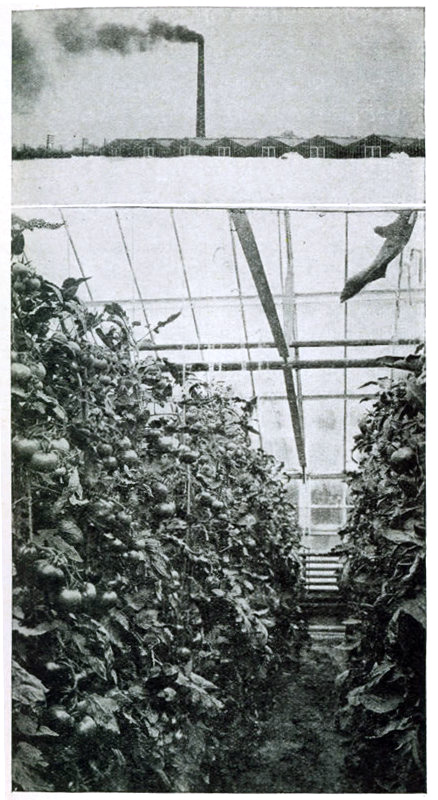 Figure 1.—The
tomato is the leader among greenhouse vegetables.
Figure 1.—The
tomato is the leader among greenhouse vegetables. In commercial greenhouses, the tomato has replaced lettuce as the principal crop and it is likely to remain an important under-glass crop until such time as the South finds practical means of getting it to market with first-class quality—perhaps, harvesting the fruit when it first shows color.
The tomato has been widely used in experiments in solution-culture of plants, sometimes called "hydroponics." The method has been in use for decades for research purposes, but has been widely publicized of recent years as a possible [20] method of commercial culture. A high degree of control of factors governing growth is undertaken and difficulties are proportionately increased. Hence no extensive commercial development has occurred. A good presentation of the method has been offered by Hoagland and Arnon. [1]
To manage a crop, one must needs know the plant. To know the various characters of the tomato helps one to master its culture.
The tomato belongs to the night shade family, the Solanaceae of the botanist, along with the potato, tobacco, petunia, pepper, eggplant, night shade, jimson weed and many other plants useful and noxious.
The tomato is a warm-season crop, sensitive to frost but reasonably resistant to heat and drought, thriving under a wide range of climate and soil. A frost free season of seventy-five to ninety days will mature home garden tomatoes in useful quantities if good plants are set but over 120 days are [21] needed for economical commercial production. Plant growing requires six to eight weeks previous to setting out-of-doors. Each fruit requires about six weeks from blossom to ripeness. The fruit ripens best for yield, color and quality when the weather is warm and sunny. Low temperatures without frost are not favorable for growth and prolonged conditions of this sort may "check" the plant and retard the response when higher temperatures come.
The tomato is sensitive to extreme day-length, setting fruit at 7 to 19 hours but not at 5 or 24 hours.[2]
The tomato responds readily to fertilizers and to moisture, coming quickly into vigorous growth after unfavorable conditions, unless too badly stunted.
As long as moisture and nutrients are available and other conditions are favorable, a tomato plant will continue to branch and blossom and make fruit almost indefinitely. A pruned single stem plant in a greenhouse at Cornell once reached a length of over 40 feet during a year and a half of [22] growth. Thus, it is really a herbaceous perennial grown in northern climates as an annual.
The plant branches freely at leaf joints but fruit clusters are formed along the bare stem,—a habit not common among plants. Some varieties are "determinate" in habit, sometimes miscalled "self-pruning," as branches only attain limited length.
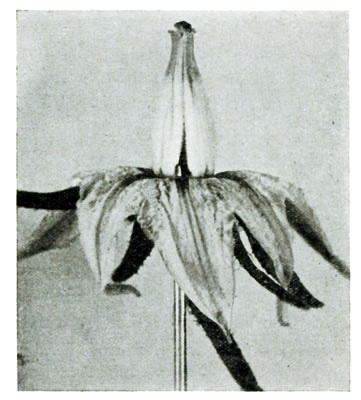 Figure 2.—The tomato flower.
Varieties differ in protrusion of pistil beyond the stamen column. If style is
too short, pollination may fail; also, if too long. A long pistil increases
danger of damage from heat and drying out.
Figure 2.—The tomato flower.
Varieties differ in protrusion of pistil beyond the stamen column. If style is
too short, pollination may fail; also, if too long. A long pistil increases
danger of damage from heat and drying out.
Hot, dry winds often damage floral parts and the blossoms drop without setting fruit.
Smith[3] has shown that pollen grains germinate best at 85° F., almost as well at 70° F., poorly at 50° F. and very poorly at 100° F.
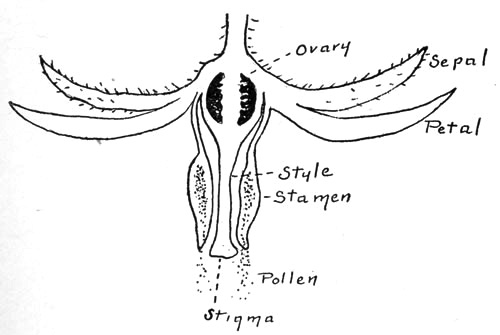 Figure 3.—Long section of
tomato flower.
Figure 3.—Long section of
tomato flower. The flowers of the tomato are borne in simple racemes or, in some varieties, in compound clusters. The flowers are normally on the plan of 5 but cultivated varieties may have six or eight [24] sepals and petals. Sepals are narrow and may be as much as an inch long. Petals are united at the base. Stamens are united by the anthers surrounding the style and stigma. The ovary or little tomato is above the calyx but, as it grows, it carries corolla and stamens outward until they, with stigma and style, drop off. Length of style is a fairly important character in its bearing on pollination and on susceptibility to heat and wind injury.
Recent experiments by several workers have demonstrated the possibilities of inducing development of fruits without pollination (parthenocarpy) by means of certain chemical compounds, notably indolebutyric acid, although others are effective.[4] This method yields seedless fruits and promises to be of value in insuring a yield of fruits under conditions unfavorable for natural setting.
Almost anywhere that other things will grow, the tomato thrives—so far as soil type is concerned.
Florida grows tomatoes on coral soils that appear too poor to produce any useful crop. The fields of South Jersey are very sandy but tomatoes do well despite costly control of moisture and fertility. In some canning sections, clay loams and even clay soils are used. The ideal is a medium sandy loam, well supplied with humus for good water holding capacity. Lighter soils are generally earlier. Tomatoes on drouthy soils are likely to suffer from blossom end rot as well as from poor growth. Good drainage is required. Muck or peat soils will grow tomatoes but they are not commonly used for commercial production.
Liming is not important for tomatoes even on fairly acid soils, assuming, of course, that the very small actual calcium requirement of the plant is met. This is generally confirmed by experiments but it does not preclude the merit of lime in favoring [26] green manure crops which, in turn, make the soil more suitable for tomatoes.
The dominant element in most sound tomato fertility programs is phosphorus with nitrogen second and potash third. Recommendations of general application are not possible but each need must be met before other beneficial additions can be fully effective.
In the home garden, a program that keeps up fertility for other crops will suffice for tomatoes. In commercial production, especially for canning, where prices received are usually low, the program must be neatly cut to fit the soil, the crop system, the value of the tomatoes and the costs of materials. A canning crop in those sections where yields are almost bound to be low, will not justify heavy investment in fertilizer. Where much is spent for irrigation, plant growing, staking and pruning, one cannot afford to curtail the fertilizer investment that will bring maximum return.
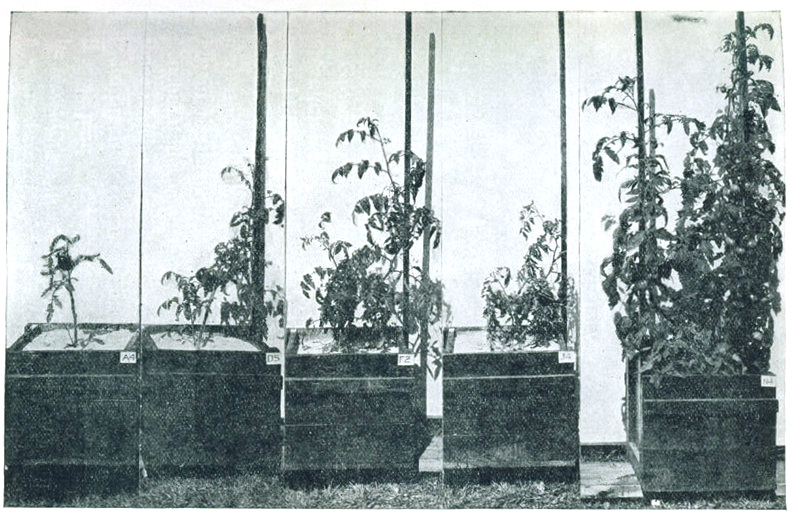 Figure 4.—How nitrate nitrogen
affects tomato growth. Plants, grown in quartz sand, with plenty of other
nutrients, received definite amounts of nitrate, in one application. A4, None.
D5, 8 grams. F2, 32 grams. J4, 256 grams. N4, Soil and manure. (1 ounce = about
28 grams).
Figure 4.—How nitrate nitrogen
affects tomato growth. Plants, grown in quartz sand, with plenty of other
nutrients, received definite amounts of nitrate, in one application. A4, None.
D5, 8 grams. F2, 32 grams. J4, 256 grams. N4, Soil and manure. (1 ounce = about
28 grams).
The task of this chapter is not to tell the grower how best to provide fertilizer for tomatoes but to help him in making his own plan for his own need. Research results and practical experience both contribute. One may well consult neighbors, [28] county agent and extension specialist, as well as the many books and bulletins that are available.
Nitrogen is very important to insure the growth of vine without which a good crop may not be expected. Lands vary more widely in nitrogen content than in phosphorus and potash. Sandy soils are commonly deficient in this element and often difficult to keep supplied. Here liberal applications are needed. Up to a hundred pounds [5] of actual nitrogen may prove profitable where other conditions justify. Heavier soils, well managed and manured during rotation, require less nitrogen and fair results may be obtained with no fertilizer where investment must be kept to a minimum.
Form of nitrogen to be used is largely a matter of economy though nitrate for part of it may be desirable early in the season when soil is cold and nitrification slow. Nitrate is desirable for side [29] dressing but even here ammonia and other forms are now considered suitable when the soil is warm.
Why do tomatoes sometimes run to vine with failure to set fruit? This is an old, old query and, since 1918, has been, directly or indirectly, the occasion of more research projects than any other horticultural topic. Kraus and Kraybill [6] set the ball a-rolling with a paper which called attention first to the observations of Klebs in Germany in which he emphasized the fact that external conditions influence conditions within the plant which in turn influence performance—a veritable chain of causation. Kraus and Kraybill then undertook to relate performance (vegetative growth and fruitfulness) to internal conditions, chiefly carbohydrate and nitrogen content of the plant tissues. These, in turn, were traced back to treatments applied to the soil.
They suggested four combinations of vegetation and fruitfulness in plants as follows:
1. Non-vegetative and non-fruitful. Plants [30] whose carbohydrate supply has been cut off, say by removal of leaves which make carbohydrates. These plants were low in carbohydrate and high in nitrogen.
2. Vegetative and non-fruitful. These plants were well supplied with both carbohydrates and nitrogen. They were of the sort we describe as having "run to vine."
3. Vegetative and fruitful. These plants were well supplied with carbohydrates, but not so liberally supplied with nitrogen, thus, providing a balance between the two that was favorable for a good crop.
4. Non-vegetative and non-fruitful. These plants had ample opportunity for carbohydrate making, but were underfed with nitrogen and so could not perform well in either vegetation or fruit-making.
Kraus and Kraybill conclude that there are certain balances between these two groups of compounds—nitrogenous and carbohydrate—which determine the nature of the plant's performance—whether there will be too little vegetative growth to permit a crop, whether the plants will "run to vine" or whether they will show good growth of both foliage and fruit.
From experiments in the same field, using definite amounts of nitrate of soda per plant, Work [7] concluded that while adequate carbohydrate supply is necessary for fruiting, excess carbohydrate did not, in itself, occasion unfruitfulness but was more likely to represent an accumulation of material unused by reason of deficiency in some other factor—often nitrogen.
It was shown that nitrate of soda does not injure tomatoes until a concentration in the soil is attained which is strong enough to plasmolyze the cells, that is to withdraw water from them by osmosis. Nor were a wide variety of nitrogen and moisture and manure treatments sufficient to induce the Bonny Best variety to "run to vine." Some varieties are subject to this trouble, mostly of the large, late types.
Murneek[8] has shown that the fruitfulness of a plant may greatly affect its internal condition, its vegetative performance and its later setting of fruit. A heavy load of developing fruit, with limited soil resources, tends to limit growth and setting. Removal of fruit induces renewal of vegetative [32] growth and of fruit setting. Failure to set fruit favors vigorous vine growth. This failure may be traceable to various causes. (1) To damage to floral parts as the blasting of the pistil by heat and drouth. Flowers of some varieties show tendency toward elongation of pistils with subsequent failure to develop normal fruit. Smith and Howlett have shown that environmental conditions as well as heredity influence this elongation. (2) To injury by insects as thrips. (3) To the character of the variety used, the Bonny group being very slightly susceptible to failure from over feeding with nitrogen while some late sorts readily "run to vine." (4) Shortage of nutrient elements as nitrogen or phosphorus or others. (5) Lack of adequate light or short day. In such cases, there may be excess of nitrogen for current need with resultant over-development of leafage. Thus, excess vegetative growth may be a result as well as a cause of poor setting.
Fertilizer experiments fairly generally point to the frequency with which phosphorus is the limiting factor among nutrients in tomato production. [33] MacGillivray[9] has studied the phosphorus content of the various parts of the plant, concluding that this element is important throughout and not alone in seed making or in rapidly growing parts as has been believed. Hepler and Kraybill[10] found some years ago and others more recently have confirmed the influence of liberal phosphorus treatments upon earliness.
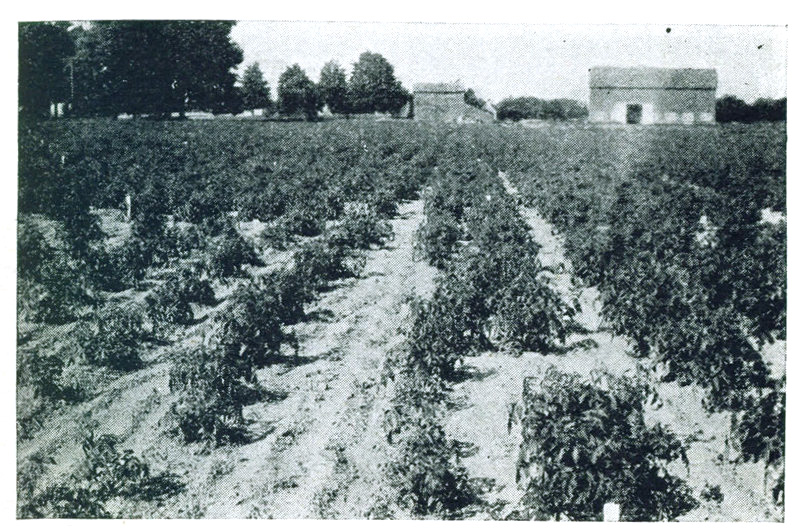 Figure 5.—Effect
of omission of phosphorus from complete fertilizer in Western New York.
Figure 5.—Effect
of omission of phosphorus from complete fertilizer in Western New York. The potash requirement of the tomato has not been as thoroughly studied as the requirement for the other two major elements. It is thought that potash has a part in building up sugars into more complex carbohydrates.
The consensus of fertilizer experiments suggests that potash is less important on most soils than phosphorus and nitrogen but that if these elements are in good supply, increased yields from potash are likely.
Lanham in Texas was unable to find a relation between potash fertilization and resistance to shipping hazards.
Stable manure has long been recognized as useful for tomatoes. It is generally considered better to apply it to the preceding crop or at least the preceding fall than to use it just before setting of plants. If spring application is necessary, it is better to use well rotted manure. Stable manure is low in phosphorus. An approximate statement would be that 10 tons of manure is roughly equivalent [35] to one ton of a 6-3-6 fertilizer. Thus, 1,000 pounds of 18% superphosphate would bring the analysis to 6-12-6 which would be generally regarded as a good balance.
A recent publication[11] from Pennsylvania emphasizes the value of manures and of phosphorus.
Recent experiments have shown the desirability of placing fertilizer close to but not in contact with the roots of the young plants. When newly set and before new roots have developed is the time when nutrient material close at hand is needed to give the plant a vigorous send-off. Transplanters have been devised with attachments to place the fertilizer in bands at each side of the row of tomatoes and about two inches deep.
Recent experiments, notably by Sayre[12] of New York, have shown the advantage of dissolving fertilizer materials in the water used for transplanting tomatoes. One combination of materials consists of ammo-phos, 14-48, 2 parts and potassium [36] nitrate, 1 part. Five to eight pounds of this mixture are dissolved in 50 gallons of water and about ¼ pint or ½ cup is applied to each plant, usually by the transplanting machine. There are other suitable mixtures of nutrients for this purpose. A very small investment in starter solutions has shown material increase in total yield. The practice places immediately available nutrients in the soil at the time and place to be of maximum usefulness to plants that have been severely root-pruned and have not yet had opportunity to rebuild the root system.
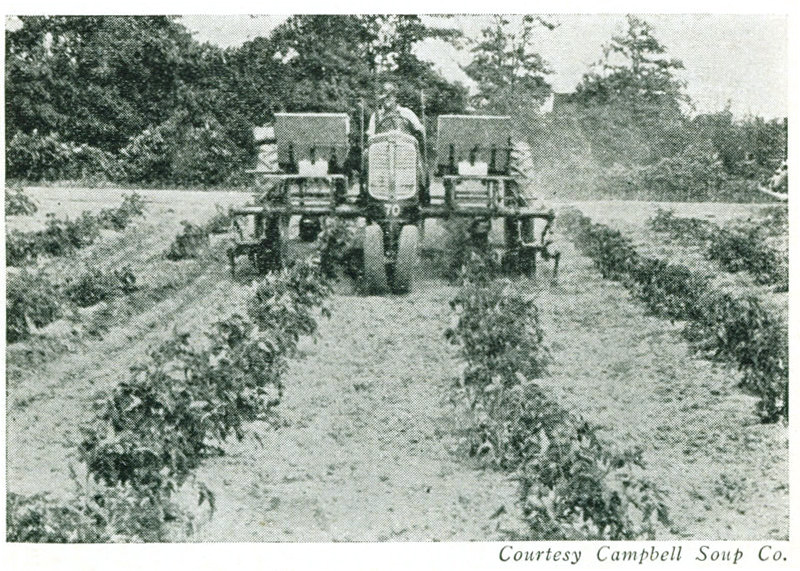 Figure 6.—Cultivating and
side-dressing tomatoes.
Figure 6.—Cultivating and
side-dressing tomatoes. Another critical stage in tomato growth comes when much fruit has been set in the clusters and demands upon plant and soil are especially heavy. At this stage, side dressing with nitrogen is helpful in maintaining plant growth and providing resources for growth and maturing of fruit. On sandy or nutrient-deficient soils, more than one side dressing may be advisable. Sodium nitrate is commonly used but other materials are suitable after the soil has warmed up. Side dressing with fertilizer in solution has been recommended recently by Tiedjens of New Jersey.
A tomato crop may be much poorer than the seed from which it grows but it can be no better.
The tomato seed is short-oval and flattened in shape, covered thickly with short silky hairs. The embryo or baby plant is coiled in a spiral and imbedded in the endosperm (reserve food supply). Three or four years is generally given as the life of the seed but it often remains viable much longer—up to 10 or 12 years in extreme cases. Good seed should germinate 85% to 90%.
Tomato seed sprouts readily, requiring fairly warm temperature, say, 70° to 75° F. for best results. It germinates very slowly at 40° to 50° F.
Being a major vegetable crop, the tomato has received much attention from plant breeders. Objectives sought include good cannery type, resistance to the fusarium wilt and other diseases, [39] better greenhouse forms, improved general market and home garden sorts, and varieties adapted for arduous conditions such as hot and dry summers or very short growing seasons.
The tomato is largely but not wholly self pollinated and pollen is not carried far. Thus, it is not difficult to breed to practically a pure-line condition.
Tomatoes for seed are usually ground up and the seed and fine pulp are separated from the skins and coarse material by screening. The juice, fine pulp and seeds are allowed to ferment from 24 to 48 hours, or until the jelly-like pulp is readily washed away. After washing, the seed is dried in thin layers and stored. A bushel of tomatoes may be expected to yield 2½ to 4 ounces of seed and an acre of tomatoes, from 100 to 225 pounds. These vary greatly according to varieties and conditions.
Wellington[13] and others have shown that first generation seed from crosses of suitable varieties show a marked increase of vigor (heterosis or hybrid vigor) over either parent or over the later generations. This fact would seem to offer possibilities [40] in practical use, but it has not thus far proved of value.
Many growers find it profitable to save their own tomato seed. The plant is an annual, the important characters are quite readily observed and natural crossing is not serious. For these reasons, the enterprise is not as difficult as with most vegetables, although, if done well, it makes heavy demands in labor and care at a time when the grower has much else to do.
The first step in selection is to establish clearly the ideal to be sought, recording it in detail on paper for future reference. Selections should be made on the basis of the plant, not of the individual fruit. It is the plant that is reproduced and the seed from "crown clusters" is no earlier than seed from later settings. The field should be searched soon after blooming time and plants that appear promising should be marked. These plants should be examined three or four times as the season advances, and markers pulled from plants that do not measure up to the desired standard. Suppose ten plants remain; all fruits from each of [41] these may be saved, keeping the seed of each plant separate. All or part of the seed may be planted in separate rows the next year for further selection and to note which parents best transmit their excellent points. If only a small amount of seed is required, direct selections may be made for use in planting for the general crop. If a larger amount of seed is required, seed from one or two of the best plants should be planted in multiplication plats. Off-type plants should be removed from such plantings, but otherwise all the seed may be saved for use. Repeated selection results in constant improvement until the stock becomes a "pure line" or practically so.
Lindstrom of Iowa has led in research on the genetics of tomatoes, chromosome relations and mode of inheritance. Many scientific papers deal with inheritance methods and results. The Yearbook of Agriculture (U.S.D.A.) for 1937 contains a valuable chapter on tomato breeding. It may also be had as Yearbook Separate 1581.
As with certain other kinds of seeds, certification service for tomatoes has now been set up in [42] several states. Certification is a most useful incentive toward care in breeding and handling and affords valuable assurance to the buyer. It is necessary to know just what is guaranteed by the certificate. It is at the same time wise to be informed as to the inclusiveness and methods of the certification.
In breeding for better varieties of tomatoes, the following are some of the characters to be sought:
(1) A vigorous vine which is necessary to produce abundant fruit and to protect from sunscald.
(2) Resistance to disease especially to fusarium.
(3) High productiveness with moderate number of fruits per cluster—say, 5 to 8.
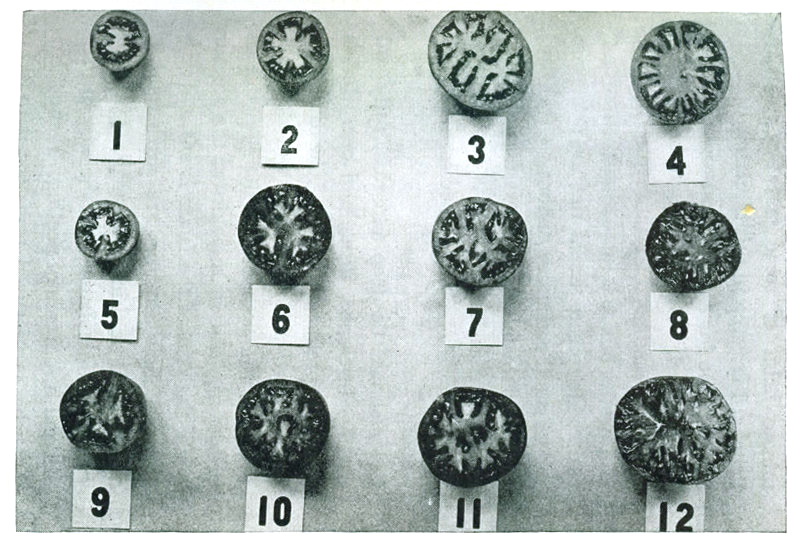 Figure 7.—Types of tomato
interiors. 1, 5. Small fruited sorts. 2, 6, 9. Bonny Best. 3, 7, 10. Chalk
Jewel. 3, 7, 11. Stone. 4, 8. Earliana. 12. Ponderosa.
Figure 7.—Types of tomato
interiors. 1, 5. Small fruited sorts. 2, 6, 9. Bonny Best. 3, 7, 10. Chalk
Jewel. 3, 7, 11. Stone. 4, 8. Earliana. 12. Ponderosa. (4) Evenness of maturity. This is somewhat out of line with the nature of the tomato but much could be accomplished toward the goal of varieties that make their crop and are gone, eliminating long picking periods and the drag of inferior fruit toward the end of the season. The so-called determinate [44] habit of some varieties such as Pritchard is a step in this direction.
(5) Size suitable for expected use and for market demand. Greenhouse tomatoes are generally smaller than those for cannery. Uniformity of size is increasingly important with wide-spread use of the lug-box pack and of small consumer cartons.
(6) Globular to oblong shape is desirable for market but is less important for cannery. Form should be symmetrical, even and smooth.
(7) Color should be deep and rich, fully and evenly developed, inside and out. Red is generally preferred to pink. The difference between red and pink tomatoes does not reside in the flesh but in the presence of yellow pigment in the skin of the former while the skin of the latter is without pigment. Yellow tomatoes are also extant.
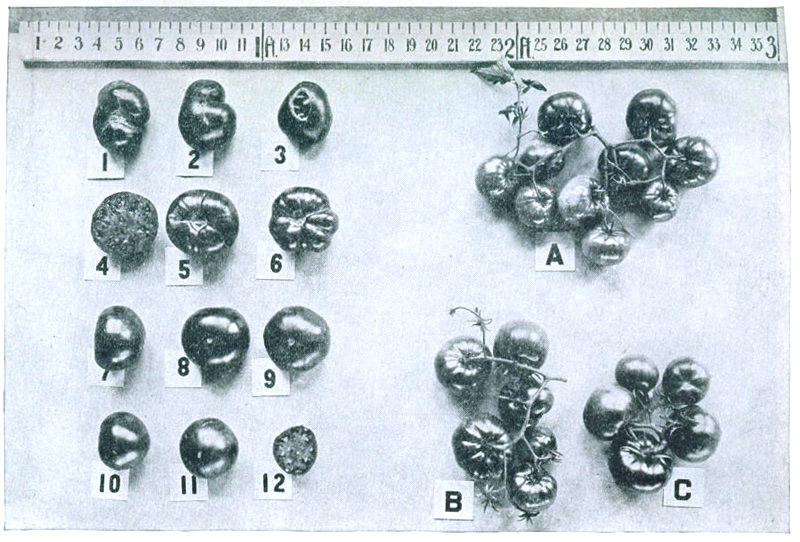 Figure 8.—he Earliana tomato. A picture of a single fruit cannot adequately describe a variety.
1-3. Rough types, common in older strains. 4. Typical interior. 5, 6. Stem end. 7-9. Good type
resulting from selection. 10-12. Pointed-round type occurring frequently in improved strains. A.
Unusually large cluster. B. Typical Earliana cluster showing compound branching. C. Unbranched
cluster of Bonny Best for comparison.
Figure 8.—he Earliana tomato. A picture of a single fruit cannot adequately describe a variety.
1-3. Rough types, common in older strains. 4. Typical interior. 5, 6. Stem end. 7-9. Good type
resulting from selection. 10-12. Pointed-round type occurring frequently in improved strains. A.
Unusually large cluster. B. Typical Earliana cluster showing compound branching. C. Unbranched
cluster of Bonny Best for comparison.
(8) Skin should be thick and tough. This safeguards against damage on the way to market and favors ease of peeling. Those saladists who serve sliced tomatoes with skins unremoved, may call for a thin, tender [46] skin but this practice finds no encouragement from discriminating partakers.
(9) Flesh should be abundant in thick walls with a minimum of watery pulp surrounding seeds. In general, a structure of many small cells is desirable.
Earliana.—The earliness of this old and popular variety outweighs its demerits where this character is required. The past ten years have seen material improvement.
Earliana is early, of small vine, with small leaves and leaflets. Clusters are compoundly branched, with many fruits. The fruits are of medium size, deep oblate, cross section often elliptical rather than circular. There are many rough irregular fruits, varying in this respect with breeding and conditions of growth. Color is red, not too deep and tending to be poorly developed at the stem end. Interior consists of many small cells with thin walls.
Bison.—represents a group of varieties bred for rigorous climates of our most northerly states. A. F. Yeager formerly of North Dakota, later of [47] Michigan, now of New Hampshire has led in this development.
Victor.—is a new variety bred originally by Yeager but introduced by K. C. Barrons of Michigan. It affords smoother, deeper and better colored fruits about as early as Earliana. It is determinate in habit and shy in foliage, increasing danger of sunscald. Rich soil and ample moisture are needed for its best development. Bounty and Home Garden are similar.
Penn State.—Penn State, developed by C. E. Myers of Pennsylvania, is not as early as Earliana. It is similar in fruit characters though distinctly better in color and shape. It is marked by short branches (determinate habit) and is designed to give an early crop to be followed by prompt abandonment of the planting. It is not to be confused with Penn State Earliana.
Bonny Group.—This group embraces our leading second early varieties widely used for home garden, greenhouse, market and cannery in the north. It includes Bonny Best, John Baer and Chalk Jewel with many additional names and with much confusion of characters among them.
Bonny Best is second early and of medium plant growth. Fruits are deep oblate to flattened globe, [48] even and smooth, of good red color, with few large, thick-walled cells.
Varieties and strains of this group vary in growth and yield, in size, shape and earliness of fruit and in suitability for greenhouse, market, cannery and juice. Stokesdale and Scarlet Dawn are meritorious newer names in the group.
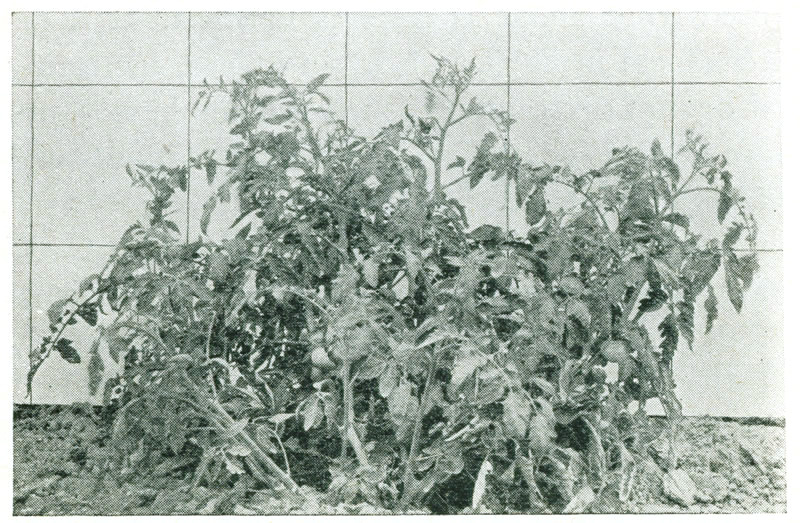 Figure 9.—Marglobe plant.
Figure 9.—Marglobe plant. Marglobe.—This variety was developed by the late Dr. F. J. Pritchard from a cross between Marvel, a French variety lending resistance to fusarium and Globe, an old variety of fine size and [49] shape. It is widely used, north and south, for market—green or ripe, for cannery and to some extent, for forcing.
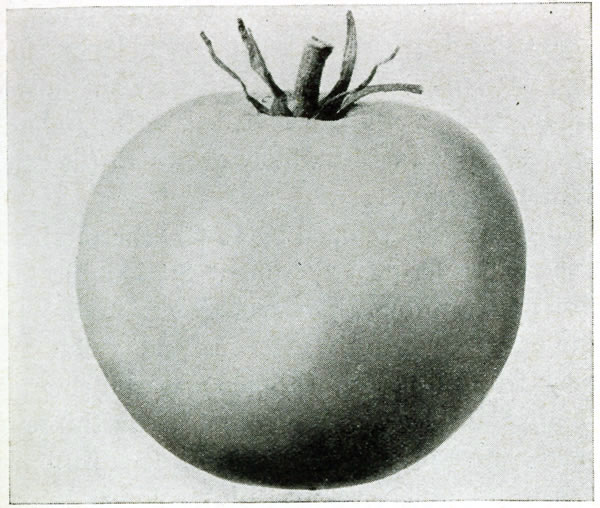 Figure 10.—Marglobe fruit.
Figure 10.—Marglobe fruit. Marglobe is a midseason variety, with large vine and foliage, resistant to fusarium and nailhead spot. Fruits are nearly globular, shapely and smooth, medium to large, scarlet red, with medium number of thick walled cells. Marglobe is rather subject to deep radial cracks.
Pritchard is of the general type of Marglobe but is earlier, with short branching habit and resistance to nailhead rust and to fusarium, and, perhaps, is less subject to cracking.
Greater Baltimore is used chiefly for canning in long-season districts. It is late, with large vine, large flat fruits of excellent scarlet red, outside and in, with many thick walled cells. Indiana Baltimore is a variant widely grown in the mid-west for cannery.
Rutgers was developed by L. G. Schermerhorn at the New Jersey Experiment Station for fine juice and canning characters—color, flavor and substance. Growth is vigorous and yields are heavy; fruits are large, flattened and well colored.
Gulf State Market is a second early shipping tomato, generally harvested green. It is flattened in shape, of well developed pink color and good interior.
Comet Group.—These trace mostly to English or other European origin and are increasingly used for greenhouse and for staking out-of-doors. Comet is small, flattened, slightly corrugated about the stem, of fine even red color, very firm and solid, with few very thick walled cells. Other names are Sunrise, and Lord Roberts. Several [51] American forcing strains have been developed with at least one parent of this group—Ideal, Grand Rapids Forcing, Field Station Comet, Trellis, Michigan State Forcing, Lloyd Forcing, Blair Forcing and others.
King Humbert and San Marzano represent the small Italian oblong tomatoes that are prized for their thick walls, fine color and suitability for puree, paste and soup.
Ponderosa is popular for home garden, a "beef-steak" tomato of very large size, irregular shape, flat, pink, with many small cells and of very mild sub-acid flavor. It is best grown to single stem. Oxheart is large, heart shaped, pink and very meaty. Others of this general type may be had in red, yellow and orange flesh. In general, the whole group lacks in prolificacy.
Oddities.—Tomato fanciers often plant seed of Red and Yellow Pear, Cherry, Currant, Peach with its fuzzy skin, Plum and others. They are prized for preserves and for decoration. Ground Cherry or Husk Tomato is not a true tomato but belongs to a different genus (Physalis). It makes excellent preserves. Well do I remember sneaking off from the other kids for solitary plunder of [52] the little row that was usually in Grandma's garden.
Comprehensive descriptions of leading varieties of tomatoes have been published by the United States Department of Agriculture in Miscellaneous Publication 160, the result of statistical and verbal notations over several years at five widely scattered stations of the country.
One of the ways to make money from tomatoes is to mature them early, selling while the price is still high. There is a big difference between $.10 a pound and $.10 a basket. Shipped and ripened green wrap tomatoes cannot be very cheap on northern markets even though Southern growers may realize little for them.
Another way to profit is to grow good plants to sell. Judging by the spindling, crowded, soft or over-hardened plants so common in stores, there should be great opportunity here and, as a matter of fact, many market gardeners do well in this business realizing welcome returns when other income is negligible.
To market ten-cent-a-pound tomatoes from out-doors requires good plants—plants that have passed through their youth nearly or fully up to blossoming time with benefit of heat and shelter and that are ready to keep up vigorous growth in [54] face of the demands of fruiting. A few scattering fruits matured early do not suffice.
Even for cannery, good plants are required. In most regions, plants are not as good as they should be. All too often, outdoor seed bed plants are set where cold frame or at least cloth cover should be employed. Further north, cold frame plants or second run or other inferior plants are used instead of the best. That is why many canning companies have greenhouses and grow plants for their farmers.
And in the home garden, the quality of vine ripened fruit along with the satisfaction of early maturity are goals worth striving for.
Plant growing is a game of skill. It calls for keen observation, constant and faithful attention to small details, and a high order of workmanship in the various operations. Furthermore, when a considerable number of plants are to be grown, it calls for good organization and rapid work if costs are not to be unduly increased. A transplanter who makes three motions where two will suffice is likely to turn profit into loss, for the loss of a second when repeated thousands of times makes many hours.
The grower who is producing tomatoes for first-early [55] maturity wants a plant that will withstand the rigors of transplanting and of inclement weather which may follow, that will start immediately into growth, and that will mature fruit in good quantity at the earliest possible date. This usually means a plant about ten inches tall, with heavy, firm, dark-colored stem (though not over-hardened), a heavy body of dark, healthy foliage, and a cluster of blossoms, with possibly a fruit or two already set. If the buds in the axils of the leaves have begun growth, no harm will be done.
Many growers are doubtful whether it is well to have fruit set on plants when they are transplanted in the field, as they claim that the little tomatoes are often lost and in any case the progress of the plant is retarded. Such plants must be handled with great skill. If they are severely checked when taken to the field, other and less advanced plants may do as well. There is danger in having plants too far advanced, and an unexpected delay in field setting may result in spindling and over-hardening that may prove disastrous. A vigorous and properly hardened plant that is younger will do better under such circumstances. Some growers protect themselves by having plants of more than one sort.
With favorable conditions and careful methods, good plants can be grown in open beds but they must be grown and used where the season is long or be grown in the south and shipped north.
Soil should be free of disease and nematodes, of good physical character, full of humus and nutrients.
Seed may be sowed a week or two after "average date of last killing frost" which may be learned from county agent or weather bureau. Further south planting times are gauged by the time tomatoes are to be set and by experience as to safe or reasonably safe sowing dates. Rows are usually a foot apart, more or less. Good plants call for sowing thinly, 6 to 12 seeds per foot, but several seeds per inch are not unusual. One may expect a million plants per acre with close planting or 40,000 plants per pound of seed.
Many millions of tomato plants are grown in open fields in the south to be sent to home gardeners in small parcels on seedsmen's orders, to be [57] sold to commercial growers or to be delivered on contract to canners.
A suitable climate and soil, good seed, freedom from disease and insects and good handling and packing are all required for satisfactory results. In far too many cases, these requirements have been sadly neglected and a good deal of distrust has been engendered. Here, as in buying seed, one must discriminate among good and poor growers. Canners who order in millions can send men south to investigate and supervise with good results.
Georgia now has a certification service for plants that helps greatly to build up and maintain high standards.
Varied programs of plant growing are in vogue in the temperate and cooler regions. A simple cold frame with or without transplanting may be employed. Seedlings may be started in hotbed or greenhouse and then transplanted to cold frames to finish the job. Some sow seed early, transplant once in the greenhouse at 1½ or 2 inches each way and then again to cold frame with wide spacing say, 4 × 4 inches or using pots or dirt bands.
For this method, as much as twelve weeks may be allowed but if space permits, excellent results may be achieved in seven or eight weeks transplanting but once to pots or to 4 × 4 inches in flat or bed.
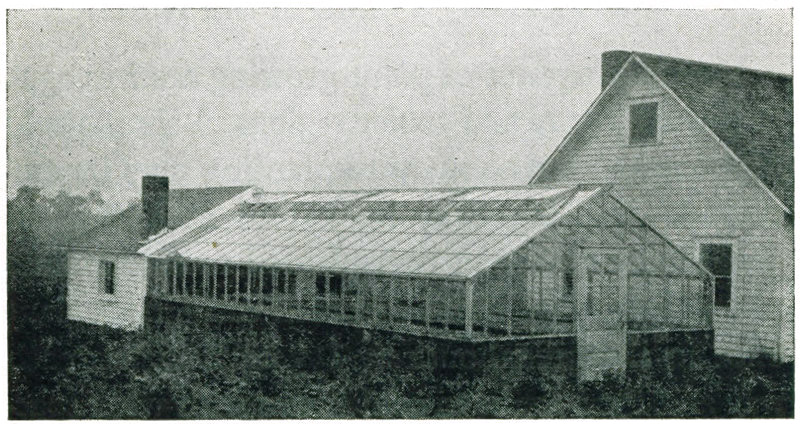 Figure 11.—A good small
greenhouse for plant growing.
Figure 11.—A good small
greenhouse for plant growing. For northern climates, greenhouses are practically required. Canneries or other large growers, have wide houses similar to those used for winter maturing crops. A market gardener may have a little house of 10´ × 20´ to 20´ × 60´ or larger as needed. If one does not object to some inconvenience and discomfort, a hotbed may be used—heated with hot water or electricity, or as in years [59] past, with fermenting manure. Cold frames may be covered with glass sash as in the case of hotbeds, or cloth may be used. There are also materials consisting of wire cloth filled with cellulose film. Special mats of straw or of quilted burlap may be used for extra cover and large growers often employ coarse manure, straw or marsh hay.
Many a tomato gets its start in life in a small flat in a kitchen window—perhaps, in a cigar box. Such seedlings may then be carried forward in hot bed or cold frame.
Growing plants directly in ground beds in the greenhouse and directly in the soil in the hotbeds or cold frames, is rather common. However, the use of flats or plant boxes in plant growing offers a number of advantages as compared with planting in the bed. Transplanting can be done at benches under conditions of comfort and convenience which make for efficiency. Moisture can be more precisely controlled and flats can be shifted if some plants grow faster than others. Plants can be moved with more dirt on the roots, and this is a great advantage when plants are sold and hauled [60] some distance, though, of course, pulled plants are handled more cheaply. On the other hand, the first cost, and the maintenance and storage of the flats must be considered. Flats may be set on the ground in the greenhouse without use of benches.
Flats are of many dimensions, ordinarily six to ten per sash or about 18 × 22 inches or 13 × 18 inches outside measure. They may be made of lumber from used boxes, but they ought to be uniform in size and made to fit beds without loss of space. The more durable kinds of wood, cypress or chestnut are preferred. Some growers make the bottoms of the flats of square-mesh galvanized screen (hardware cloth), about five or six meshes to the inch. This allows roots to penetrate the soil of the beds, permits root pruning by shifting, and there is no wooden bottom to rot.
Some growers use clay pots for plants which are receiving special care. Their cost is an obstacle though they are used repeatedly. Such pots also hold less soil for the area occupied than flats or square dirt bands.
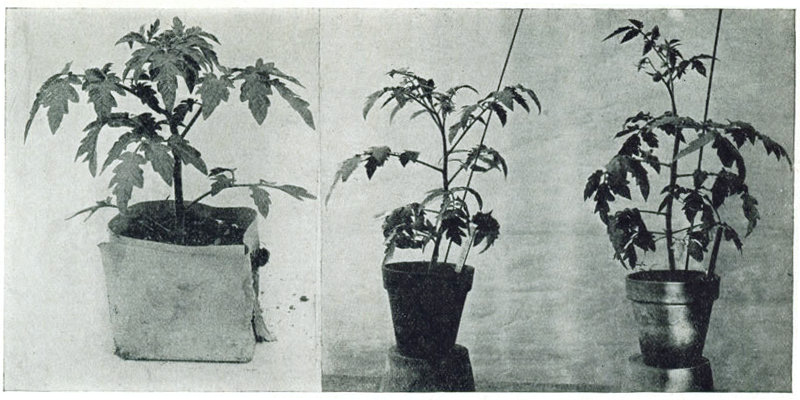 Figure 12.—Plants
for the early crop. 1. Shows plants in paper bands of excellent proportion and
thrift but not yet in bloom. 2. In blossom but fruit has not yet set. 3. Similar
to 2 but a little further advanced and has actually set fruit.
Figure 12.—Plants
for the early crop. 1. Shows plants in paper bands of excellent proportion and
thrift but not yet in bloom. 2. In blossom but fruit has not yet set. 3. Similar
to 2 but a little further advanced and has actually set fruit. Paper pots are used to some extent. Organisms decomposing the paper may use and so render unavailable some of the nitrogen of the soil thus hindering the growth of the plants. This may be [62] corrected by seeing that abundant nitrogen is present in the soil either when made up or by later application of nitrate sowed upon the soil while plants are dry or applied in solution in watering.
Dirt bands of veneer are used and are very satisfactory. Blocking as practiced by many growers is a cheap and effective way of attaining much the same results.
When the cold frame is prepared for the last transplanting, two inches of fairly well-rotted manure is laid down and two or three inches of prepared soil is placed on top. Plants are set about four inches apart each way. About a week before field setting, a butcher knife, or a hoe which has been straightened and sharpened, is run between rows both ways. This cuts the roots whereupon the plant at once begins to form new feeders within the block thus reducing, to some extent at least, the damage which might be caused by transplanting. The method is also used with flats.
Soil for plant growing should be free of disease and nematodes, friable, not readily forming a crust, receiving and retaining moisture well, but drying off quickly on the surface after watering and well supplied with nutrients. A sandy loam base with good humus content is desirable. It may be prepared, beginning a year or two ahead by growing and plowing under well fertilized green manure crops. Or a compost heap may be prepared with successive layers of soil and manure or other humus making material. In either case, it is usually mixed a time or two by shoveling over or by passing through a shredding machine or a coarse screen.
If trouble is likely to be experienced from damping-off fungi, the soil may be heated to 200° F. and held there for an hour, using oven or electric or steam sterilizer. Seed may also be treated with red copper oxid or semesan.
Tomato seed runs about 125,000 to 150,000 per pound. An ounce of seed is usually depended [64] upon for plants for an acre. For growing seedlings, seed may be sowed up to 100 or more per foot of row. For a maximum number of strong seedlings from a small amount of seed, thinner sowing is desirable. Rows are usually about two inches apart, and a quarter of an inch is sufficient cover. The seedlings break ground in a week or ten days.
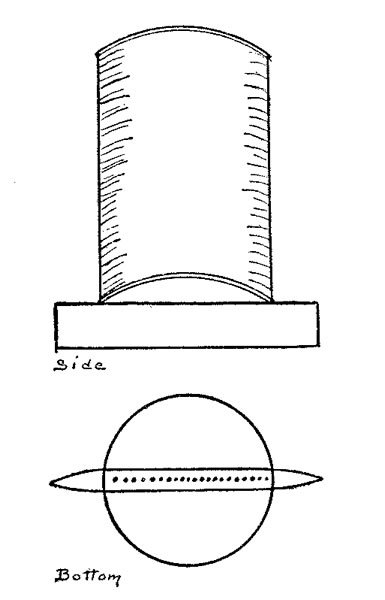 Figure 13.—Tin can prepared for
sowing tomato seed.
Figure 13.—Tin can prepared for
sowing tomato seed. Uniformity of depth of rows and of covering is important. Otherwise, seedlings will come up unevenly and there will be considerable waste.
Water and heat should be provided to permit a steady and moderate rate of growth in plants. Over-watering and high temperature yield soft and spindling plants and also plants that are overgrown and that are liable to severe checking before field setting. Under-watering and low temperature give stunted plants. The thermometer at the earlier stages of growth may well stand around 70 to 75 degrees by day and 10 degrees lower at night. A reasonable range of temperature and moisture gives opportunity for the skillful grower to forward or retard his plants as seems best. Great care should be exercised to water evenly. It is necessary to watch the plants constantly to detect the slightest variations in growth. The watering may then be modified and even progress insured.
Ventilation finds its chief significance as a means of controlling temperature and humidity, though actual change of air may be a factor.
High soil moisture, high humidity, high temperature, and faulty ventilation, all favor the ravages of the various damping-off fungi mentioned above which cause little plants to rot off near the ground.
The main advantage of transplanting plants before they are set in the field is to give them increased space, or, in other words, to conserve space in greenhouses and frames. Other advantages have been claimed, but in many instances the gains have resulted from more space rather than from the actual shift. Transplanting checks growth through breakage and disturbance of the root system. Loomis[14] finds that "the immediate effect of transplanting is a reduction in the water supply, and the immediate and long-time results are dependent upon the severity and duration of such reduction." Transplanting has little effect upon very young plants and a shift at the age of six or eight weeks checks the plant about as much as two earlier transplantings. The tomato falls in the group of plants that stand transplanting well, roots being rapidly replaced. Transplanting breaks roots and so results in the growth of branches which are shorter than the members of the old system. The new system is accordingly less severely damaged in later transplantings.
To insure efficiency, the work of transplanting merits careful attention. Carelessness as to details means loss through unevenness of plants. For example, if soil is not carefully packed at the edges and corners of the flats, irregular water supply and irregular growth result. If much transplanting is to be done, it pays to divide up the work, as is done in a factory. Have a good place for doing the work—a warm, light, and comfortable room. Tired workers are not efficient. Spotting boards are of service if properly made and correctly used. Soil should always contain just the right degree of moisture to allow holes to stand open. Care must be taken that the workers in setting plants do not double the roots or close the holes at the top leaving the roots dangling in an open space below.
It is said that a good worker will prick out 10,000 plants per day, though everything must be convenient to accomplish this and many growers regard 6,000 plants as a good day's work.
Pruning of tops injures rather than helps the plant, for it destroys leaves which are the machines that make carbohydrates, the principal material [68] for growth. Pruning to cure legginess is bad. Proper management of time, temperature and water will provide adequate control and if plants should become leggy, it is better to plant them by laying them down in a trench with a few inches of top above ground than it is to prune them.
Nipping out the growing point with the first cluster of flower buds is sometimes practiced to encourage branching and a heavier yield of early fruit. If this is done, ample space and nutrients must accompany careful management. Otherwise, the plant finds itself with inadequate resources to do a big job.
Tomato plants cannot be made frost proof, but low temperature, reduced moisture supply, partial starvation, and crowding all tend to make plants more resistant to cold, to drying winds, to heat, to mechanical injury such as breakage of leaves and stems, and even to cut-worm attacks. Plants can be hardened appreciably in a short time—say a week. It is now generally accepted that moisture control is more useful than reduced temperature as a means of hardening. Starving and crowding are not desirable methods. Plants can be kept on [69] the dry side if glass or other water-shedding cover is available.
Great care must be exercised to avoid over-hardening of tomato plants, for in this way a check in growth is incurred from which they recover slowly, and perhaps never fully.
Much study has been given to the changes in plants which underlie the hardening process, and papers by Harvey, Rosa, Loomis, and others should be consulted in this connection.
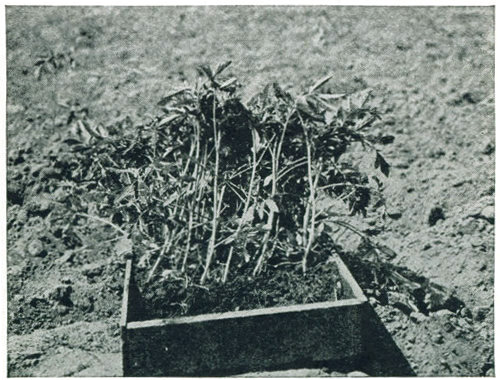 Figure 14.—Plants
that have been crowded and overgrown, probably undernourished and over-hardened.
Plants like this are very often set in the field. They are definitely slow in
starting growth.
Figure 14.—Plants
that have been crowded and overgrown, probably undernourished and over-hardened.
Plants like this are very often set in the field. They are definitely slow in
starting growth. Watts[15] has shown that adverse conditions, especially low temperature and water deficiency prevailing at the time when fruit clusters are barely beginning to form, commonly occasion the development of misshapen fruits.
Faithful spraying or dusting with Bordeaux in the plant bed has proved a useful means of forestalling destructive leaf blights which often devastate whole fields.
The tomato is not especially exacting as to care after it has been set out-of-doors. It will do business if given half a chance. At the same time, much can be done to favor earliness, good yield and high quality.
In general, tomatoes are set in field or garden as soon as danger of frost is reasonably past. Suppose May 1st is average date of last killing frost. Growers would make general plantings from May 18th to 25th though, in rare instances, frost might occur as late as May 28th or 30th. The last week of May is planting time over a vast area of the North. Venturesome souls will set home garden plants as early as May 10th, standing ready to replant if necessary. There is little gain in rushing the season too much, however, for the tomato is not only sensitive to frost but it does not thrive under what [72] people call "raw, mean, chilly weather." Such conditions may also be responsible for misshapen fruits. A grower for local market not infrequently risks a share of his plants before safe setting time in the hope that warm weather may give the crop a good start toward early ripe fruit to sell at high prices.
Delayed planting and use of plants that do not start quickly into vigorous growth is the cause of heavy losses in the north, especially among cannery growers. Better quality and heavier yields are attained if the bulk of the crop matures before cool weather in the fall. In the south, it is necessary to get good plant development and a full set of fruit before hot weather which often destroys the blossoms.
Many forms of plant protectors are on the market—of paper and of other materials. These act as little greenhouses for the individual plant, protecting against frost and promoting growth. Plants may be set out-of-doors a couple of weeks earlier by their use. The most common forms are of translucent paper reinforced by pasted strips of [73] paper or by wire. The trick is to devise one that is cheap, that will admit maximum light and that will withstand the weather. For tomatoes, they need to be tall, which makes the problem of wind resistance more serious.
For emergencies, opaque cover, baskets upside down or even newspaper may be used. Many a field has been saved by burying the plants when frost threatened, carefully uncovering when danger is past.
Untrained tomatoes are set at distances from 3½ feet each way to 7 × 7 feet or even more. The extreme width is found on rich irrigated lands in California where plants make tremendous growth. The closer spacings are found on lighter soils where humus, plant food, and moisture are not too abundant. The variety should also be considered. Sixteen square feet per plant is about average.
Check row planting is common, though it is not feasible where transplanters are used. Wider spacing between the rows than between plants is desirable as it permits later cultivation one way and leaves a better passage for pickers with less damage [74] to plants and fruits. Thus, 3½ × 4½ feet might be preferred to 4 × 4 feet.
Rows for single stem, staked and pruned plants may be as close as three feet and plants may be as close as eighteen or even twelve inches, though some growers contend that two feet is close enough.
The essential point in field setting is to pack the soil firmly about the roots, thus establishing maximum contact for moisture absorption. Whatever the method of planting, the aim should be to get the plants from the old home to the new with as little delay and check in growth as possible. For the first-early crop, they should be moved so that "they never know it." With bands, pots or blocking in flats or beds, it is feasible to avoid practically all disturbance of roots.
The tomato will, under ordinary favorable conditions, take hold and grow even if shaken quite free of earth. Plants, however, should be dug loose rather than pulled, to prevent undue breakage of roots.
Plants ought to be watered well some hours before transplanting. Transplanting machines and [75] hand planters of the Masters type give a little shot of water at the root, thus helping to establish contact with the soil. Starter solutions are discussed on page 35. These machines are commonly used for cannery setting and, to some extent, for market tomatoes. Blocked plants can be set pretty fast by hand with much less disturbance of roots. Some manage to set potted or blocked plants by machine, keeping a ball of earth about the roots.
The rows are usually marked out fairly deeply, plants are dropped in fours between rows and it is a very short job to pack soil about the clod of earth in which the plant is growing. Another method is for one worker to make an opening with a spade. A second places the plant in the wedge-like opening and the first steps on the soil to firm it solidly about the roots.
Plants are generally set a little deeper than in the plant bed.
The old idea about cultivation was "the more, the better." More recent experiments notably those by Thompson have shown that little need be done beyond controlling weeds. He found that stirring the soil gave no significant increase in [76] yield over mere scraping sufficient to destroy weeds. It is pretty hard to convince many old time gardeners of this. The value of dust mulch for conservation of moisture has been pretty well discredited by experimental comparisons.
Irrigation is not essential for tomato production in humid climates and is seldom provided except under market garden conditions. Water is occasionally an asset in a dry season and, of course, the grower who waters at such times reaps a harvest in higher prices as well as in increased yield. The advantage of irrigation is especially marked if dry weather retards plant growth and delays maturity of the first of the crop, for the high prices of the early market are involved. Judicious irrigation will sometimes continue production for late fall market. Yet gardeners seldom plan permanent overhead equipment for tomatoes. The movable lines that are now used to a considerable extent serve well for the tomato crop.
The furrow method of irrigating tomatoes is the most common in the West. This plan allows the water to make its way down the rows, slowly soaking [77] in all along the line. The tomato stands drouth better than many of our crops, especially if the soil holds moisture fairly well, either naturally or through a liberal humus content. Excessive moisture is doubtless a factor in causing the plants to run to vine and drop their blossoms. Hence, in western sections, it is customary to water thoroughly just before or just after setting the plants and then to avoid applications until the setting of fruit is well advanced.
Thorough soaking is better than frequent light waterings, as it encourages a better development of root system. An Idaho bulletin suggests three irrigations. Late irrigations tend to delay ripening of fruit, but this object is sought in the late fall shipping districts of California which find their best markets after eastern crops have been nipped by frost.
Irrigation must be handled with care to avoid cracking of fruit, which occurs when soil becomes rather dry and then is heavily watered. Watering late in the season is said to make fruit watery and of poor quality.
R. A. Emerson[16] in 1903 reported results of careful comparisons between vegetables that were cultivated and others that were mulched with straw. These results indicate that mulching gives good results with tomatoes, both as to yield and quality. However, frost injury was more severe on mulched plats, and Emerson points out that the mulch should not be applied until the plants are well established.
Mulching is recommended by a good many writers and growers and it seems to be practiced to some extent in Missouri. The advantages claimed are conservation of moisture and clean, fine quality fruit. L. W. Purdum and Sons of Virginia use 4-5 tons per acre of wheat straw, staking their plants and irrigating. They report unusually heavy returns per acre under these methods. The Missouri people apply as much as sixteen tons per acre, making the cover five or six inches thick. The practice of mulching, however, is not common, and the cost will likely prevent its general use.
Growers attending conventions will often stay up half the night to argue about training and pruning tomatoes and to debate the details of their favorite procedures.
For home garden, the method is strongly commended. Many market gardeners follow the practice and it has gained materially of recent years in New England. Some market reports quote staked tomatoes separately and at a materially higher level than fruit from unpruned plants.
Most of the southern shipping sections follow the practice and it is practically universal in greenhouses.
One way is to drive a stake by each plant tying at several points along the stem with cheap twine. The other plan, recently gaining in favor, is to set posts every 25 feet or so, string a heavy wire on top, and another a foot from the ground. Cheap jute twine is strung between wires and the tomato plants are merely twisted around the string. Tying [80] is not required. Some omit the lower wire, tying a non-slipping bowline loop around the plant near the ground. In either case, plants are kept trimmed to a single stem though occasionally an extra branch is allowed to grow. In southern Illinois, plants are tied to a short stake without pruning.
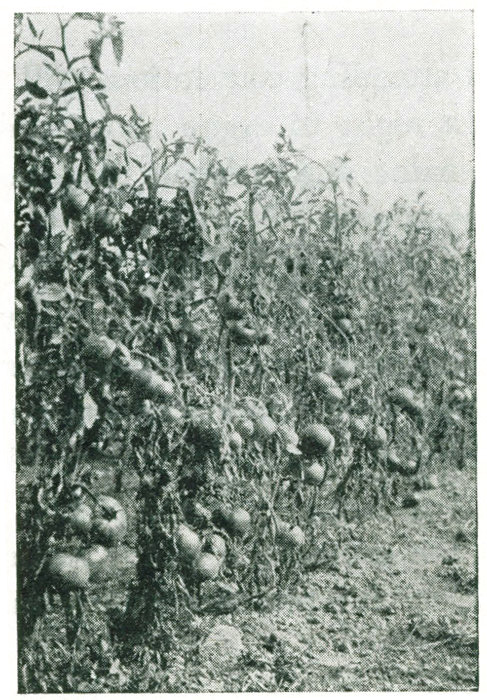 Figure
15.—Tomatoes pruned and trained with post, wire and
twine. This is the trellis system of New England.
Figure
15.—Tomatoes pruned and trained with post, wire and
twine. This is the trellis system of New England.
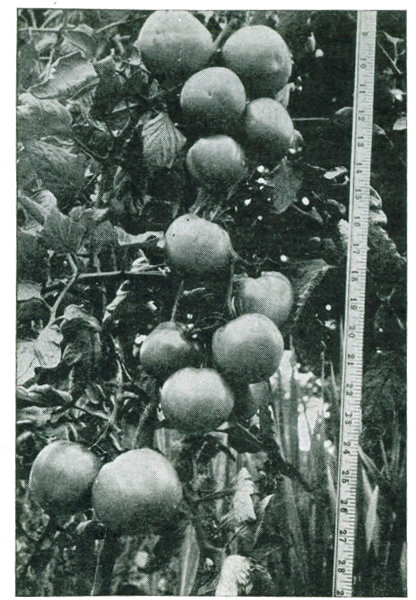 Figure 16.—Fine clusters on
trained plants.
Figure 16.—Fine clusters on
trained plants. The advantages claimed for pruning and training are:
Earliness.
High yield per acre.
[82]Ease of cultivating and spraying.
Ease of picking.
No injury from snails and wire worms.
Quality of fruit:—size, color, smoothness and cleanliness.
Crop finished earlier.
Less sunscald.
The disadvantages claimed are:
Many plants required.
Reduced yield.
More blossom-end rot.
Higher cost of labor.
Cost and care of stakes and wire.
The validity of each of these points varies greatly with conditions; in fact, the answer to the whole question depends largely upon the location and the ideas of the grower. In trying to reach a conclusion, it is well to realize that training makes certain radical changes in the plant. It loses leaves through pruning, it is supported from the ground, and it is spaced differently. Since the leaves manufacture the basic substance for themselves, and for the rest of the plant, removal of leaves reduces the resources of the plant. H. C. Thompson[17] has[83] found that the root system is reduced about in proportion to leaf reduction. It is fairly clear that single-stem training greatly reduces the yield per plant, and other methods result similarly in proportion to the severity of pruning. When plants are spaced closely enough together the yield may be brought up to that of areas unpruned and unstaked. Idaho experiments indicate that staking alone does not affect the total yield, but that it does favor early maturity under the different pruning systems. The disadvantages of training are largely economic. Will the marketing conditions justify the extra cost of staking and pruning?
Experiments have shown pretty clearly that sunscald, blossom-end rot and cracking are worse on trained plants. Using varieties of good foliage will help the first trouble while uniform and adequate water supply achieved by selection of suitable land, by building humus content of the soil and by irrigation will solve the latter two problems. Thompson found increased yield of early fruit. Other evidence is somewhat conflicting but, in general, it supports Thompson. It is generally agreed that pruned plants yield larger, cleaner and more perfectly formed and colored fruits. Ease of spraying or dusting and of picking is important.
For pruned plants, 3½ feet between rows and 1½-2 feet between plants is about right.
To train or not to train is a question that one must answer for himself as the controlling factors vary too widely—costs of stakes, wire and labor, prices of early tomatoes and possibility of cultivating a more or less fancy trade.
The tomato, in most regions, is not one of our most "pestered" crops. Although over thirty diseases of tomatoes are discussed in books and bulletins, most of them are only occasionally serious or are subject to definite control methods. Enemies are generally worse in the warmer climates.
Most home garden tomatoes and many commercial crops are grown without benefit of spray or dust. If trouble arises, county agent or college specialist can usually advise, suggesting methods suitable for local conditions.
Experience must, of necessity, be the guide in shaping a program and costs must be carefully balanced against results.
The principal measures that are widely used are seed treatment against damping off, use of resistant strains against fusarium wilt and application of bordeaux mixture against leaf blights.
As with all plants, thoroughness must be the watchword in spraying or dusting. Timeliness, [86] choice of weather conditions so far as possible, and covering all surface lightly rather than throwing on heavy blotches of spray or dust all require careful attention.
Fusarium Wilt (Fusarium lycopersici) is perhaps the most serious of all the tomato diseases although it occasions little trouble in the more northerly states. It is troublesome as far north as New Jersey to Iowa.
The fungus winters in the soil, enters through the roots and blocks the water passages of the plant causing wilting, yellowing, and finally, death. Water vessels in the stem are discolored,—another means of identifying the disease.
Spraying or dusting are of no service since the fungus is within. Long time rotation and use of the many resistant strains are effective means of control.
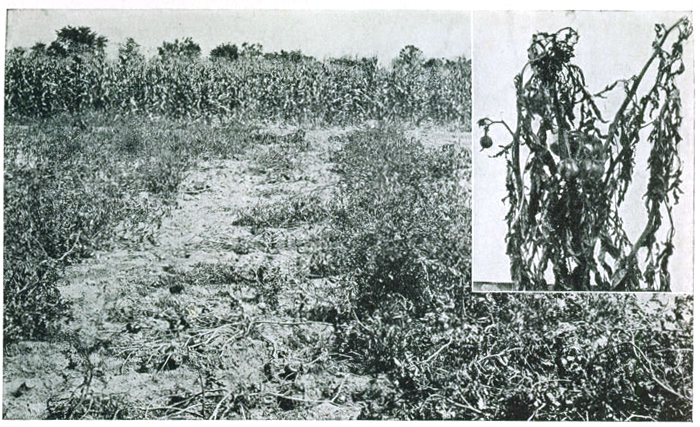 Figure 17.—Resistance to fusarium wilt. Row on left center is planted to an ordinary variety, row on
right with one of F. J. Pritchard's wilt-resistant selections. Insert shows plant attacked by wilt fungus.
Figure 17.—Resistance to fusarium wilt. Row on left center is planted to an ordinary variety, row on
right with one of F. J. Pritchard's wilt-resistant selections. Insert shows plant attacked by wilt fungus. Leaf Spot, Septoria Blight (Septoria lycopersici) causes heavy loss by destroying the foliage and so the fruit-making power of the plant. It also opens the fruits to sunscald. The spots appear as small dark water soaked areas which enlarge but little though they increase in number and turn brown. Tiny black dots, the fruiting bodies of the fungus, appear. The spores germinate only on moist leaves [88] and the disease is spread by wind, rain, workers and the like. It winters on refuse of the tomato and related plants.
Fall plowing helps to control. Bordeaux spraying beginning in the seed bed and carried faithfully through the season will usually hold the trouble in check.
Late Blight (Phytophthora infestans) is the same fungus as the late blight of potatoes, affecting both foliage and fruit. It is often troublesome the first few weeks after plants are set out-of-doors. Clean soil in seed bed and bordeaux spraying are helpful.
Western Blight, Yellows, Curly Top,—cause unknown,—is prevalent in California. Leaves roll and become thickened and brittle, later turning a sulfury yellow. Veins become purplish. The trouble prevails in hot weather. The cause is likely a virus, similar to or identical with the curly top of beets. It is apparently spread by leaf hoppers. No satisfactory control has been devised though there is some promise in resistant strains.
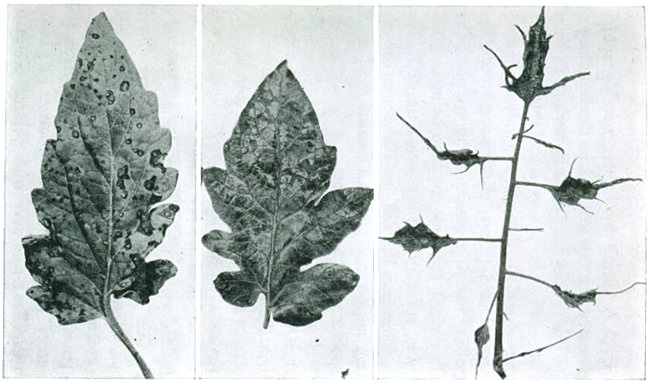 Figure 18.—Diseases of the
tomato. 1. Septoria or leaf spot. 2. Mosaic. 3. Mosaic, filiform.
Figure 18.—Diseases of the
tomato. 1. Septoria or leaf spot. 2. Mosaic. 3. Mosaic, filiform. Mosaic.—No organism has been definitely connected with the mosaic diseases of tomatoes, but they are highly infectious, being spread by means of what is called a "virus," which passes the finest [90] filters. It is spread by insects, notably aphids, which carry plant juice, and in the handling of plants, but it does not persist in seeds or in litter. It is wintered on horse nettles and three species of ground cherries. Control suggestions include roguing affected plants, eliminating weeds, and controlling carrying insects. The symptoms are widely various, the most common being mottling of leaves, stunting and malformation of leaflets, which sometimes become fine ribbons or threads, curling, appearance of small brown dead areas, and spots and cracks on fruits.
Damping off is caused by various fungi in the seed bed which attack the stem near the surface of the soil and cause the plant to drop over and die. Clean soil, heating of soil, commonly called sterilization, and care in watering are all helpful. It is now common practice to dust seed with formaldehyde dust, or with red copper oxid or with an organic mercury disinfectant. If trouble is serious, a watering with semesan just before seedlings emerge may be helpful.
A government bulletin on "Market Diseases of Tomatoes" (Miscellaneous Publication 121, 1932) is an excellent summary with colored plates to help in recognizing the various troubles.
The Fruit Worm (Chloridea obsoleta) is probably the worst of the tomato insects, but is not prevalent in the North. It is the same as the corn ear-worm or the cotton boll-worm, and bores into green or ripening fruits. It winters in the soil and fall plowing is recommended for its control. Planting corn as a trap crop is also suggested. The Virginia Truck Experiment Station finds that the addition of two pounds of calcium arsenate to 50 gallons of the Bordeaux used for disease control helps materially.
Cut-worms (various species of the family Noctuidae) cause severe losses at the time of field setting. They winter in the soil and are worse when sod has been plowed under, or following other host plants. Poison bran mash is commonly used to combat them, using a spoonful to each plant. Hand picking and the use of paper collars are resorted to on a small scale. Well-hardened plants seem less subject to injury by these pests than tender plants.
Colorado Potato Beetle (Leptinotarsa decemlineata) can cause a world of damage to young plants. Arsenical spray or dust will ordinarily [92] control them. The old-fashioned potato bug (family Meloidae), is reported as troublesome in Missouri. When they appear in droves, the only control is to drive them with brush. Arsenical spray or dust is of some value.
Flea Beetles (family Chrysomelidae) are the little black jumping fellows that perforate leaves in plant beds and in the field. They are also accused of injuring blossoms and reducing the set of fruit. Their attacks upon young plants are sometimes ruinous. Bordeaux with arsenical serves as a repellant. Dusting with nicotine sulphate dust is also suggested.
Green Tomato Worms, or Horn Worms (Phlegethontius sexta) are big, green fellows and have a great capacity for tomato foliage. Hand-picking and arsenical spray or dust are usual means of combat.
The stalk-borer (Papaipema nitela) is a slender caterpillar which is reported as serious in Indiana. No satisfactory control is suggested except clean culture around fields and pinching the stems to destroy the pest.
The most skillful production is in vain if marketing is not done well. At the same time, the quality of the goods is the principal factor in making the price and in moving the goods. Even then, if costs in production and marketing are too high, the enterprise is a failure.
The differences between high and low quotations on the same market the same day, are usually fairly wide,—say, $1.75 to $2.50; or $0.75 to $1.25; or $0.20 to $0.25 per basket. These differences are sufficient to make the difference between profit and loss. Small differences in quality of the product, in handling and dress-up of the market pack and skill in finding buyers may easily result in price differences as great or greater than those indicated.
Picking in the field calls for the closest care and supervision to prevent damage to the fruits and [94] vines. Stems should be removed to avoid punching other fruits, and long finger-nails do great harm by cutting the skin and admitting infection. Containers should not be too large to be handled conveniently. Round half-bushel stave baskets and galvanized pails are excellent. Baskets made of quarter-inch staves rather than veneer are smooth and durable, but the investment is rather heavy unless dumping is resorted to. In practice, all sorts of boxes and crates are used, often the package that is used for marketing. No container as deep as a bushel basket should be used.
The stage of ripeness at which tomatoes are picked depends upon the time and distance to market. For home use or local market, fruit may range from the first turn to almost fully colored.
A few growers pick at the turn and use ripening rooms to prepare for local selling. In this way cracking, injury by soil, by insects, and by uneven coloring are avoided. Fruits are wiped and handled with less loss and may even be washed if need be.
Fully ripened fruit will not stand handling and hauling and will quickly deteriorate, reaching the consumer in bad condition.
For cannery, full ripening is desired with even[95] coloring. MacGillivray[18] has shown that success in this is largely a matter of care in picking. Cracking and slight softening are not serious defects for this purpose, but molds and bacteria in broken places are serious as they throw the product out of grade or occasion rejection.
Most tomatoes for long distance shipment, are picked before color appears,—at the mature-green stage. One of the great difficulties is to judge this stage correctly; to train ordinary labor to pick by maturity and not by size. Immature-green tomatoes ripen slowly and do not achieve good appearance or table quality.
It is almost impossible to describe the ear marks of a mature-green tomato. Most of those usually cited are of doubtful value—glossy surface, whitish cast of color and the dark ring at the stem scar. The jelly-like or mucilaginous material in the seed cells has sufficiently developed in a mature green tomato so that the fruit may be sliced without cutting seeds. Of course, the tomato is ruined [96] but the method can be used to check one's judgment based on the exterior. Also, one can learn by laying aside tomatoes judged mature-green and immature-green to ripen.
Some efforts have recently been made in Florida to pick tomatoes at the turn, that is, at the first show of color, a practice suggested by Sando[19] some years ago. This should provide fruits of uniform degree of maturity, that would be about ready to sell on arrival and it would eliminate the serious problem of immature-greens. It would require more frequent picking of fields and there could be no delay in packing. There would, doubtless, also be problems of temperature and ventilation in transit. Results of tests thus far have been rather encouraging.
Green wrap tomatoes are received at terminal markets by produce houses that have special ripening rooms where temperature is kept at about 70°, with high humidity to prevent wilting or shriveling. Ethylene gas is used by some to [97] hasten ripening. It does not change the nature of the process, merely speeding it up. Some of these repackers have elaborate equipment for sorting and packing.
The tomatoes, on arrival, are shaken out of their paper wraps. Any that have ripened in transit are taken out and packed while the greens go into the ripening rooms. They may have to be sorted over two or three times as ripening progresses.
The ripening process in tomatoes has been rather thoroughly studied. Sando found that tomatoes ripen uniformly, regardless of size, at a certain age, dating from the setting of the fruit. This time, which, of course, varies according to weather conditions, was eight weeks when the studies were made. Ripening is accompanied by an increase in moisture, acids and sugars, with decrease of solids, nitrogen, starch, pentisans, crude fibre and ash. Sugars increase from about a quarter to about half of the dry weight. Chemical analysis did not show differences sufficient to account for the difference in quality between vine-ripened fruit and green fruit ripened in the laboratory. Lack of ventilation seems to be detrimental.
It is commonly held that tomatoes chilled without freezing will not ripen satisfactorily afterward. This belief is discounted by results of Wright and associates and of Platenius who found little effect of low temperatures upon later ripening.
Wright[20] and Platenius[21] have both found that tomatoes should not be stored at low temperatures, 50° to 60° F. being best. Storage is not likely to be satisfactory for more than a month.
Waxing of tomatoes by immersion in a dilute water emulsion of paraffine and carnauba waxes is being tried out with very promising results. Waxes are also dissolved in volatile hydrocarbons and sprayed on. Moisture loss and shriveling are materially retarded, and interference with the ripening process is negligible. The wax coating is very thin, adds an attractive gloss and is entirely harmless.
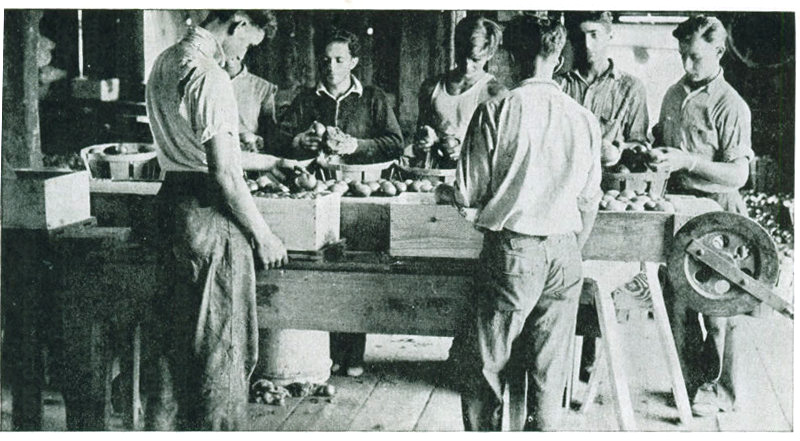 Figure 19.—Packing tomatoes on
a farm in Connecticut. Boys in the background are wiping and sorting. The others
are packing in half-bushel boxes. The top slats are put on before packing and
the bottom is nailed on at the finish of the job. A board which is turned over
with the box keeps tomatoes from falling out.
Figure 19.—Packing tomatoes on
a farm in Connecticut. Boys in the background are wiping and sorting. The others
are packing in half-bushel boxes. The top slats are put on before packing and
the bottom is nailed on at the finish of the job. A board which is turned over
with the box keeps tomatoes from falling out.
It is generally true that at market the poorest products in a given lot tend to fix the price. When the buyer finds a few inferior specimens he assumes there are many more. Imperfect and diseased specimens infect others. Grading enhances the appearance of the pack.
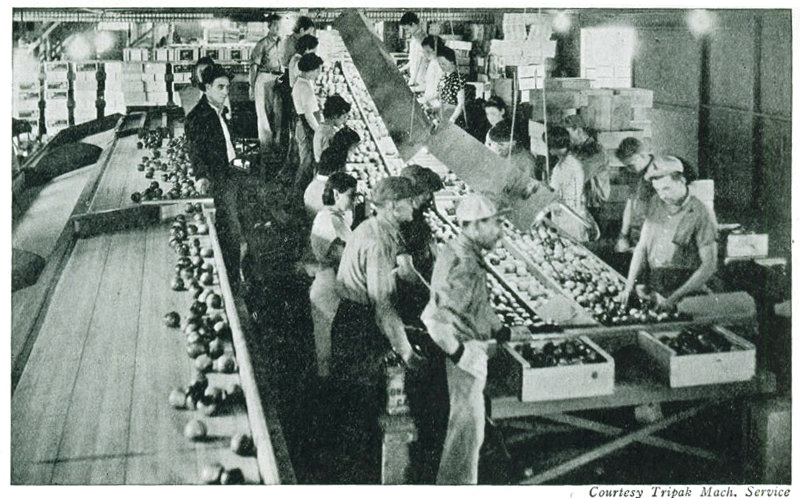 Figure 20.—A California packing house with elaborate machinery and fully organized.
Figure 20.—A California packing house with elaborate machinery and fully organized. Of course, the grower who picks marketable tomatoes and leaves unmarketable fruits on the vine is engaged in a form of grading—informal and subconscious. Methods may range from this simple practice to the elaborate schemes adopted in large packing houses. There is no difficulty in adopting methods for the farm that are easily managed and perfectly practical. In general, two grades to sell represent a good plan, leaving culls at home unless prices are high and there is good demand for them. The set-up may involve no more than a worker at a table with three baskets—one with tomatoes from the field; another for #1's and a third for #2's. The worker may well use a cotton flannel glove or cloth to wipe the tomatoes and the fruits should be placed in layers to bring the package to a good face. With some practice, this slows the operation but very little. Shed packing [102] should be more common than it is though the practice seems to be gaining.
Shippers scattered from Cuba and California to New York state have packing houses set up to all degrees of elaborateness. Some have machines and conveyors that wash, sort for size, provide for hand sorting for grade and deliver to bins for packing. Experienced packers advance with the season from Florida to Lake Erie. These workers become almost incredibly expert and speedy. It is not uncommon for a worker to pick up, wrap and place in the lug box 60 or 70 tomatoes per minute—not as a show-off but in course of regular work.
 Figure
21.—Puffiness is a common defect in tomatoes,
especially when grown in the winter in the South.
Figure
21.—Puffiness is a common defect in tomatoes,
especially when grown in the winter in the South. The federal government has worked out and published standards for the grades of tomatoes along with most other vegetables. These standards are practical and have found wide acceptance as furnishing common language between seller and buyer, especially for long distance shipment. The one who grades may, however, set up a standard of his own to meet the needs of his conditions and market.
U.S. Standards for cannery tomatoes are widely used as a basis of payment to the grower and this practice is to be commended.
The lug box has almost wholly replaced the older 6-basket carrier and 4-basket flat for shipment of tomatoes. It is in almost every respect, a good package for tomatoes. It is built with solid board ends, with veneer or sawed sides, bottom and cover. Cleats on the ends serve to raise the lids so that a bulge pack will not be injured by pressure. Veneer covers and bottoms are held together by stitched veneer cross pieces. The lug box is packed in three layers and holds about 30 pounds net of tomatoes though it is often over-packed [104] to carry considerably more. The bulge pack is desirable only so far as it is necessary to insure a tight pack and to take up the small shrinkage that takes place in transit. Ordinarily, it goes beyond this. It results in delivery of more tomatoes than are paid for, and in bruising because the top center is too high.
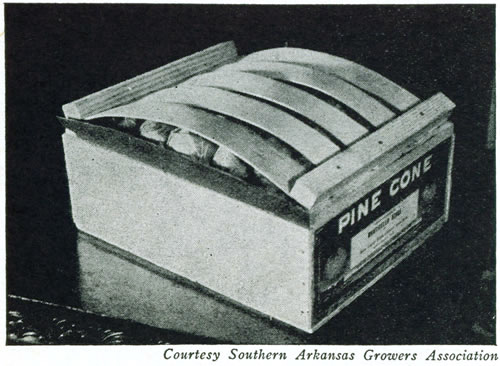
Figure 22.—The lug box is the most widely used of all tomato packages. This is well packed and labeled but shows too much bulge making for difficulty in loading and handling and increasing danger of bruising the upper fruits.
The late M. R. Ensign in Florida, was working with a wire-bound lug to carry 20 pounds of tomatoes in two layers without bulge.
The lug box is packed in three layers and the size of fruits is designated by the number of tomatoes each way,—6 x 6, 6 x 7, and 7 x 7 being the commonest sizes. Each tomato is wrapped in a square of tissue paper which may or may not be printed. The principal advantage of the paper is to cushion the pack and protect the tomatoes against rubbing and abrasion. Where tomatoes are small, U.S. Standards provide for "bridge pack" or partial extra layers, for extra rows and for double wraps or two tomatoes in one paper.
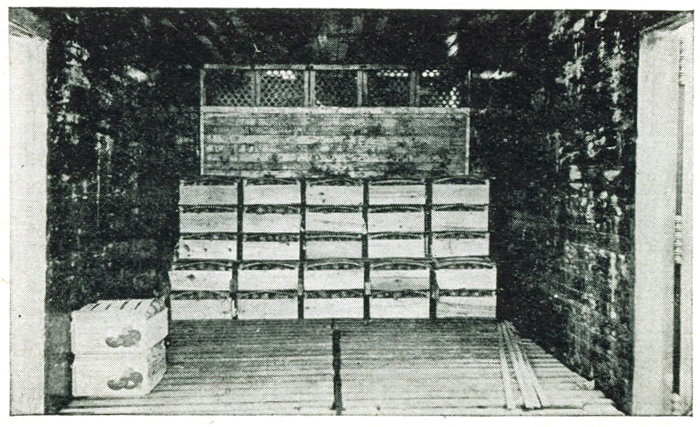 Figure 23.—Lug boxes as loaded
in car.
Figure 23.—Lug boxes as loaded
in car. Lug boxes were formerly loaded lengthwise of the car but are now generally loaded crosswise,—that [106] is, the side of the box is crosswise throwing the heavy endwise thrust against the substantial end of the box. Thin strips are nailed between layers, butting against the sides of the car to prevent shifting of the load and closing of ventilation channels. Refrigerated cars are generally used but icing is not usual.
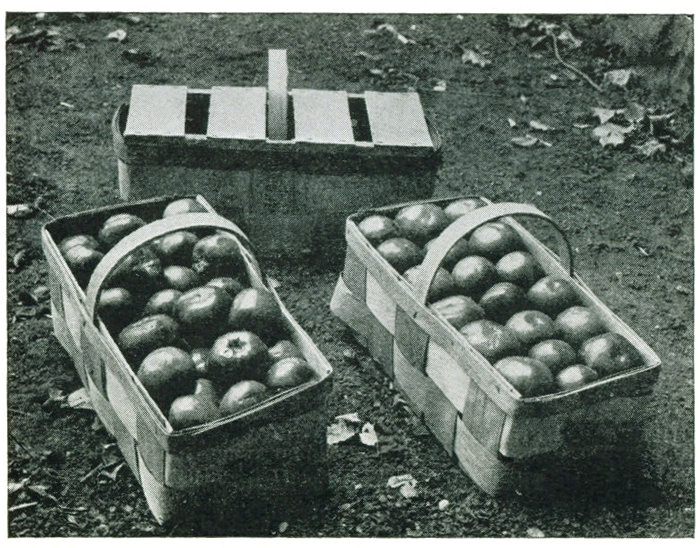 Figure 24.—The square braid basket is widely used
as a local market package for tomatoes. The faced pack looks better and is
easily put up. Covers permit stacking six or eight high.
Figure 24.—The square braid basket is widely used
as a local market package for tomatoes. The faced pack looks better and is
easily put up. Covers permit stacking six or eight high. A few shipping sections, notably New Jersey, still use the 12-quart climax basket for tomatoes.
Local markets use various containers for tomatoes,—the Boston bushel box; a half bushel of the same depth also used in New England; lug boxes; the Jersey tomato crate; and very commonly, 8 and 12-quart square braid veneer market baskets. Peach baskets and bushel baskets are now used but little, being too deep for good carrying. The diamond market basket of earlier years has about disappeared—being too flexible and not suited for stacking. The square braid with suitable cover may be stacked very satisfactorily in trucks but is hardly substantial enough for rail shipment.
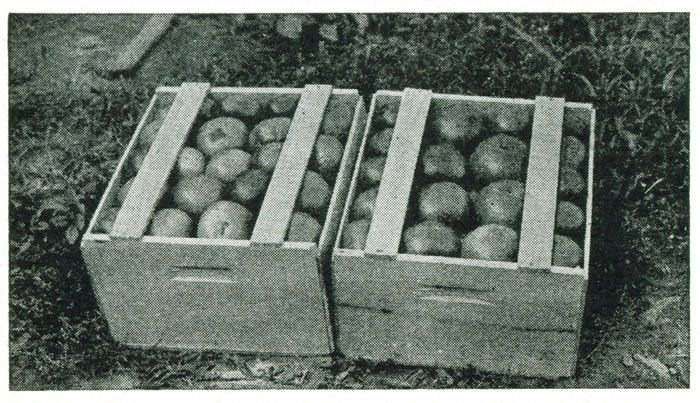 Figure 25.—The
Connecticut half bushel box. Figure 19 shows how this is packed.
Figure 25.—The
Connecticut half bushel box. Figure 19 shows how this is packed. Hot house tomatoes travel in square braid, climax or paper fibre baskets, now rather commonly, [108] the latter. The Cleveland section sells some millions of baskets of 8-quart capacity but carrying 8 pounds of tomatoes in two layers, usually with stems on, usually wrapped and sometimes with a paper divider between layers.
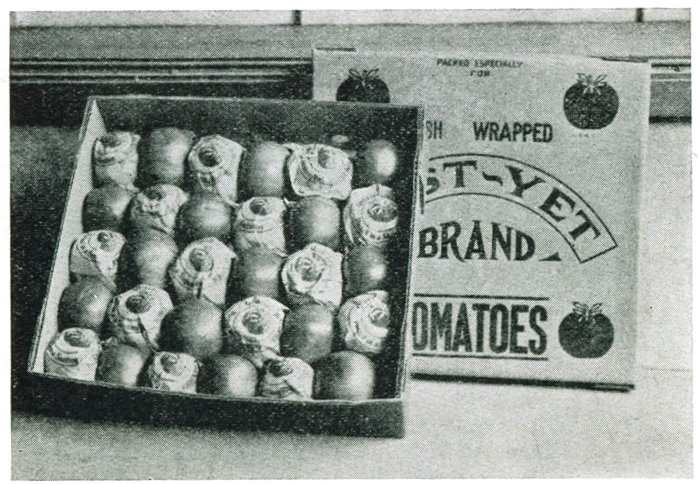 Figure 26.—Repacked
tomatoes. Southern tomatoes go to wholesale houses that specialize in ripening
and repacking. Many kinds of packages are used. The flat 10-pound box is one of
the popular packs especially in the Boston area.
Figure 26.—Repacked
tomatoes. Southern tomatoes go to wholesale houses that specialize in ripening
and repacking. Many kinds of packages are used. The flat 10-pound box is one of
the popular packs especially in the Boston area. 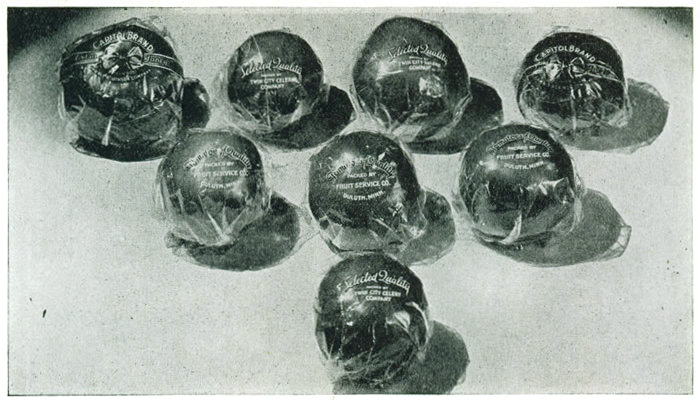 Figure 27.—Cellulose film is used for repacked tomatoes.
Figure 27.—Cellulose film is used for repacked tomatoes. Cannery tomatoes move in field crates belonging to the canner or, in Jersey, in 5/8 bushel baskets, about as awkward a container as could be readily devised unless it should be the Jersey [110] tomato crate with its two cover strips permanently fastened.
Repack tomatoes are sometimes replaced in lugs or in half lugs. Ten pound corrugated cartons are widely used, newer and fancier packs being but one layer deep. Fruits are wrapped with paper or cellulose film. An increasing proportion of repacks are now put up in one-pound cartons with a window of cellulose film, carrying four or five tomatoes. A variation is a paper tray wrapped with cellulose film.
Good marketing calls for a good label for whatever package is used. These are usually pasted on the package. Paper containers are often printed directly but the problem of misuse of second hand packages is coming to the fore.
Success in selling demands in the producer the qualities which we ordinarily expect in the business man. The good grower is a business man if he succeeds, and this will be more true in the future than in the past, as competition increases. It is necessary to judge the men one deals with, forming estimates as to reliability and character. [111] Mutual confidence is essential to satisfactory dealings. It is worth while to study the produce business and to learn its ins and outs, reading a trade paper, talking with dealers, and making trips to markets.
Shipments are made on "f.o.b." or track sale, on consignment, or on joint account. The first plan of outright sale is the most desirable and is possible where there is enough business at a given point to attract buyers or where grades and business standing are well enough established to assure the purchaser of what he is getting. When the quality of the product is uncertain or when markets are glutted, consignment must be resorted to. Under this plan, the shipper owns the goods until the receiver makes a sale and all the risks up to this point are his. There are many consignment houses of high character if the shipper will take the trouble to find them instead of shipping to any one who writes a good letter, and there is vigorous competition in the trade. These factors make it possible to secure fairly good service most of the time. Joint account selling, where shipper and receiver agree on how returns shall be divided, is sometimes undertaken where mutual acquaintance justifies it.
Selling on distant markets is more complex and difficult than local selling for many reasons. Shoving crates off the wagon into the car and forgetting them is not selling. Co-operative organization has helped many communities through pooling of resources, standardizing, grading and packing the product, encouraging better field practices, and securing the services of able managers and salesmen.
A very small amount of produce is sold by producers directly to the consumer at his home, but the roadside market has greatly developed retail activity by growers. Here fine quality, attractive appearance, moderate prices, and fair dealing are effective in building business. Stands that plan to "fleece them as they pass" do not last long. It is the return business that counts. The bulk of local selling is done directly to retailers—grocers or hucksters—either at market or store-door. The costliness of this system is being realized and local commission business is growing, in many cases through the establishment of commission houses co-operatively owned and managed by growers, [113] as in Providence, Cleveland, Chicago and other markets.
Some effort has been made to increase the use of tomatoes as has been successfully done with oranges and bananas. These efforts have been sporadic and results have been hardly more consistent than the efforts. Co-operative publicity, especially at times when large quantities are to be moved, would seem to offer fine possibilities. Growers of some crops are finding chain store groups very ready to help in moving out large volumes of produce when the supply is large.
Cannery sales are generally made at a stipulated price on contracts closed in advance of planting. These contracts have usually devoted more words to protecting the interests of the packer than those of the grower, largely because the grower has accepted the canner's initiative with little question. Farseeing companies have been fair in enforcement of terms and liberal in their dealings, realizing that prosperity must be mutual for the highest success. A few canners have contract provisions that enable the grower to share in prices [114] realized for the packed product when they rise beyond a certain figure. Too many canners have lacked vision, however, and have taken all they could get. Farmers have known little about costs and so have frequently been lured by the prospect of cash return even though they see no money until the packed tomatoes are actually sold. During recent years, much has been learned about the business side of growing for cannery purposes and the knowledge has been made available through extension channels. Growers have shown some tendency to organize and some canners welcome this movement as helping them to set their affairs on a plane of definite understanding. Canners have suffered sadly through failure of growers to live up to contracts if it suited them better to evade the terms, and organization helps greatly to develop the producer's sense of responsibility. Indiana has formed a federation of locals, but an organization movement in another state failed, more because the directors and members did not live up to their duties than through opposition of certain hostile canners. Co-operation in this field has the same possibilities, requirements and dangers as in other fields. With time and experience, [115] co-operation will be an increasing and beneficial factor in the business.
In some sections, most of the cannery tomatoes are sold on open market, and in others, the early part of the crop is free for local sale or shipment. This arrangement would seem to have possibilities for further development by the use of good plants and good culture.
Happily, the home gardener does not need to keep books with his tomatoes. If he likes the culture and the product, he need not inquire further.
Not so with the commercial grower. After all skill has been exercised in growing and selling, the books must show black and not red. This calls for good management and judgment not only as to what is best for the tomatoes and for the consumer but also how much one can afford to spend to gain a given advantage.
Fortunately, quality, yield and economy generally go hand in hand. One of the best ways to achieve low unit cost is to win a high yield per acre.
For the cannery crop, conditions are sometimes such that one cannot afford to apply, say, optimum fertilizer because some other factor not readily controlled may limit the returns and so make heavy feeding uneconomical.
Yield.—The average yield per acre of cannery tomatoes for the United States was, in 1940, 5.39 tons per acre and the 10-year average, to 1938, was 4.15 tons per acre. For tomatoes for fresh market, the average yield for 1940 was 148 bushels per acre, 14 bushels above the 10-year average. Of course, these yields would not satisfy a grower who calls himself successful. In the canning sections of New York, it takes about 7 tons per acre to cover costs of production. Some years ago a survey in Arkansas recorded costs as low as $36 per acre. However, the same survey showed cost per ton as $13.64. Cannery contracts that year averaged about $12.75 per ton. That does not yield much money to bank even if ten or twenty acres are grown. Rarely yields run to 25 tons per acre.
It is accordingly necessary to keep costs down and to bring yields up. Each item of cost must be scrutinized and adjusted to bring lowest cost per ton or per package.
In counting costs, it is necessary to include every element. The following summary from 118 Western New York farms for 1934 for cannery tomatoes illustrates the various items:
| Per cent | ||
| of total | ||
| Growing costs: | ||
| Land | $ 7.66 | 9.17 |
| Manure | 3.91 | 4.68 |
| Commercial fertilizer | 8.21 | 9.83 |
| Plants | 15.55 | 18.62 |
| Plowing | 3.40 | 24.10 |
| Fitting | 3.83 | 4.59 |
| Applying fertilizer | 1.65 | 1.98 |
| Setting | 5.41 | 6.48 |
| Cultivating | 6.38 | 7.64 |
| All other growing costs | 2.14 | 2.56 |
| ——— | ——— | |
| Total growing costs per acre | $58.16 | 69.65 |
| Harvesting and delivering (8.2 tons) | 25.34 | 30.35 |
| ——— | ——— | |
| Total costs | $83.50 | 100.00 |
All too often, growers think they are counting costs when such important items as interest, use of truck and machinery or others are omitted. One sometimes sees such figures in print.
One good way to view returns is in terms of cents per hour for labor. Cost accounts in New York have showed that a group of farmers who raised cannery tomatoes the nine years up to 1937 and whose records were studied, realized $0.34 per hour for their time given to tomatoes, $0.51 for potatoes, $0.24 for wheat, and $0.11 for oats.
This book is not a monograph in the scientific sense and no attempt has been made to cite references for all statements. This list is intended to include the publications that are likely to prove most useful to one who wishes to read further about tomatoes. There are many others of great value, most of them being included in bibliographies in the works cited below.
Unless otherwise stated, references are to publications of the state experiment stations, addresses of which may be obtained by writing Office of Experiment Stations, United States Department of Agriculture, Washington, D. C.
Beattie, W. R. Tomatoes as a truck crop. U.S. Dept. of Agr. Farmers Bul. 1338. 1923.
Snyder, G. B. and Dempsey, P. W. Tomato production in Massachusetts. Mass. Ext. Leaf. 51. May, 1937.
Porter, D. R. and MacGillivray, John H. The production of tomatoes in California. Calif. Exp. Sta. Cir. 104. 1937.
Cochran, H. L. Improved methods of tomato production in Georgia. Ga. Exp. Sta. Bul. 206. 1940.
Huelsen, W. A. Growing tomatoes in Illinois. Ill. Exp. Sta. Cir. 451. 1936.
Balch, W. B. Growing tomatoes in Kansas. Kan. Exp. Sta. Cir. 172. 1933.
Seaton, H. L. Tomato growing in Michigan. Mich. Exp. Sta. Ext. Bul. 156. 1936.
Allen, E. J. and Talbert, T. J. Tomato culture in Missouri. Mo. Exp. Sta. Cir. 173. 1934.
Schermerhorn, L. G., Tiedjens, V. A., et al. Questions and answers relative to tomato production. N.J. Exp. Sta. Ext. Bul. 174. 1936.
Raleigh, G. J. Growing tomatoes for market. Cornell Ext. Bul. 377. 1937.
Tracy, W. Tomato culture. Orange Judd Co. 1907.
Work, Paul. Tomato production. Orange Judd Co. 1926.
Pellett, F. C. and M. A. Practical tomato culture. A. T. De La More Co. 1930.
Atwater, W. O., and Woods, C. D. The chemical composition of American food materials. U.S. Dept. of Agr., Office of Expt. Stas. Bul. 28. 1896.
Sherman, H. C. Food products. Macmillan. 1924.
Miller, Elna. Tomatoes, their value and uses. Utah Exp. Sta. Cir. 47. 1932.
Ellis, Eliz. E. Using tomatoes in family meals. N.H. Exp. Sta. Cir. 225. 1940.
Beattie, J. H. Tomatoes for canning and manufacturing. U.S. Dept. of Agr. Farmers Bul. 1233. Rev. 1930.
Lancashire, E. R., Parks, T. H. and Pierstorff, A. L. Tomatoes for canning. Ohio Exp. Sta. Bul. 114. 1935.
Hester, J. B. Good, fair or poor tomatoes from your soil. Campbell Soup Co., Bul. 2. 1940.
Cruess, W. V. Commercial fruit and vegetable products. McGraw-Hill. 1924.
Pederson, C. S. Preparation of tomato products. N.Y. Exp. Sta. Cir. 178. 1937.
Gaylord, F. C. and Fawcett, K. L. A study of grade, quality and price of canned tomatoes sold at retail in Indiana. Ind. Exp. Sta. Bul. 438. 1939.
Saywell, L. G. and Cruess, W. V. The composition of canning tomatoes. Calif. Exp. Sta. Bul. 545. 1932.
MacGillivray, J. H. and Ford, O. W. Tomato quality as influenced by the relative amount of outer and inner wall region. Ind. Exp. Sta. Bul. 327. 1928.
MacGillivray, J. H. Tomato color as related to quality in the tomato canning industry. Ind. Exp. Sta. Bul. 350. 1931.
Gaylord, F. C. and MacGillivray, J. H. Tomato quality studies. Field and harvest factors affecting grade. Ind. Exp. Sta. Bul. 394. 1934.[122]
Hauck, C. W. Marketing cannery tomatoes on grade in Ohio. Ohio Exp. Sta. Bul. 504. 1932.
Beattie, J. H. Greenhouse tomatoes. U.S. Dept. of Agr. Farmers Bul. 1431. Rev. 1939.
Hoffman, I. C. Growing of greenhouse tomatoes. Ohio Exp. Sta. Bul. 499. 1932.
Burk, E. F. and Roberts, R. H. Growing greenhouse tomatoes. Wisc. Exp. Sta. Bul. 418. 1931.
Gilbert, B. E. and Pember, F. R. Relative efficiency of various organic supplements in the growth of greenhouse tomatoes. R. I. Exp. Sta. Bul. 236. 1932.
Gilbert, B. E. and Pember, F. R. Economical amounts of nitrate of soda to apply in the greenhouse for the growth of tomatoes. R. I. Exp. Sta. Bul. 252. 1935.
Bouquet, A. G. P. An analysis of the characters of the inflorescence and fruiting habit of some varieties of greenhouse tomatoes. Cornell Exp. Sta. Memoir 139. 1932. Biblio.
Seaton, H. L. and Gray, G. F. Histological study of tissues from greenhouse tomatoes affected by blotchy ripening. Jour. Agr. Research (U.S. Dept. of Agr.), Vol. 52, No. 3, pp. 217-224. 1936.
Boswell, V. R. Improvement and genetics of tomatoes, peppers, and eggplant. U.S. Dept. of Agr. Yearbook. 1937. pp. 176-206. Full biblio.
Boswell, V. R., et al. Description of American varieties of tomatoes. U.S. Dept. of Agr. Misc. Publ. 160. 1933.
Muller, C. H. A revision of the genus Lycopersicon. U.S. Dept. of Agr. Misc. Publ. 382. 1940.
Morrison, Gordon. Tomato varieties. Mich. Exp. Sta. Spec. Bul. 290. 1938.
Myers, C. E. and Lewis, M. T. The effect of selection in the tomato. Penn. Exp. Sta. Bul. 248. Rev. May 2, 1930.
Yeager, A. F. Tomato breeding. N.D. Exp. Sta. Bul. 276. 1933.
Pritchard, F. J. Development of wilt-resistant tomatoes. U.S. Dept. of Agr. Bul. 1015. 1922.
Wellington, Richard. Comparison of first generation tomato crosses and their parents. Minn. Exp. Sta. Tech. Bul. 6. Rev. 1923.
Groth, B. H. A. The F1 hereditary of size, shape, and number in tomato fruits. N.J. Exp. Sta. Bul. 242. 1912.
Lindstrom, E. W. Hereditary correlation of size and color characters in tomatoes. Iowa Exp. Sta. Research Bul. 93. 1926.
Porte, W. S. and Wellman, F. L. Development of interspecific[124] tomato hybrids. U.S. Dept. of Agr. Cir. 584. 1941.
Babb, M. F. and Kraus, J. E. Results of tomato variety tests in the great plains region. U.S. Dept. of Agr. Cir. 533. 1939.
Anon. A haploid marglobe tomato. Jour. of Heredity, Washington, D. C. Vol. 27, No. 11, 1936.
Huelsen, W. A. New wilt-resistant tomato varieties for field and greenhouse. Ill. Exp. Sta. Cir. 448. 1936.
Nissley, C. H. Plant growing and plant growing structures. N.J. Ext. Bul. 51. 1926.
Tussing, E. B. and Lancashire, E. R. Growing vegetable plants. Ohio Ext. Bul. 103. 1930.
Raleigh, G. J. Starting vegetable plants. Cornell Ext. Bul. 448. Oct. 1940.
Crist, J. W. Ultimate effect of hardening tomato plants. Mich. Exp. Sta. Tech. Bul. 89. 1928.
Harvey, R. B. and Wright, R. C. Frost injury to tomatoes. U.S. Dept. of Agr. Bul. 1099. 1922.
Seaton, H. L. and Strong, M. C. Southern-grown vs. locally grown tomato plants. Mich. Quarterly Bul. Vol. 20, No. 3, pp. 131-141. 1938.
Alexander, L. J., Young, H. C. and Kiger, C. M. The causes and control of damping-off of tomato seedlings. Ohio Exp. Sta. Bul. 496. 1931.
Van Haltern, Frank. Control of tomato seedbed diseases[125] of southern plants. Ga. Exp. Sta. Bul. 187. 1935.
Work, Paul. Tomato fertilizer experiments in Chautauqua County, New York. Cornell Exp. Sta. Bul. 467. 1928.
Hartman, J. D., Work, Paul Wessels, P. H. Tomato fertilizer experiments on Long Island. Cornell Exp. Sta. Bul. 676. 1937.
Mack, W. B., Stout, G. J. and Rahn, E. M. Fertilizer experiments with tomatoes. Penna. Exp. Sta. Bul. 393. 1940.
Sayre, C. B. Effects of fertilizers and rotation on earliness and total yields of tomatoes. N.Y. Exp. Sta. Bul. 619. 1933.
Sayre, C. B. Starter solutions. Farm Research (N.Y. Exp. Sta. Geneva) Vols. 5, 6, and 7, No. 2. April 1939, '40, '41.
Parker, M. M. Tomato fertilization. (1) The effect of different fertilizer ratios on the yield to tomatoes. Va. Exp. Sta. Bul. 80. 1933.
Carolus, R. L. Tomato fertilization. (2) The effect of different fertilizer ratios on the chemical composition of tomatoes. Va. Exp. Sta. Bul. 81. 1933.
Thomas, R. P. Effect of fertilizer treatments of a soil on the quality and yield of tomatoes. Md. Exp. Sta. Bul. 386. 1935.
Friend, W. H. Tomato varieties and fertilizers for [126]the lower Rio Grande valley of Texas. Texas Exp. Sta. Bul. 438. 1931.
Comin, Donald and Bushnell, John. Fertilizers for early cabbage, tomatoes, cucumbers, and sweet corn. Ohio Exp. Sta. Bul. 420. 1928.
Hepler, J. R. and Kraybill, H. R. Effect of phosphorus upon the yield and time of maturity of the tomato. N.H. Exp. Sta. Tech. Bul. 28. Rev. 1926.
Hester, J. B. Soil fertility in tomato production. Campbell Soup Co. Bul. 3. 1941.
Thompson, H. C. Pruning and training tomatoes. Cornell Exp. Sta. Bul. 580. 1934.
Watts, V. M. Pruning and training tomatoes in Arkansas. Ark. Exp. Sta. Bul. 292. 1933.
Hibbard, R. P. The various effects of frost protectors on tomato plants. Mich. Exp. Sta. Tech. Bul. 124. 1932.
Thompson, H. C. Experimental studies of the effects of cultivation of certain vegetable crops. Cornell Expt. Sta. Memoir 107. 1927.
Kraus, E. J. and Kraybill, H. R. Vegetation and reproduction with special reference to the tomato. Ore. Exp. Sta. Bul. 149. 1918. Biblio.
Work, Paul. Nitrate of soda in the nutrition of the tomato. Cornell Exp. Sta. Memoir 75. 1924.
Arthur, J. M., Guthrie, J. D. and Newell, John M. Some effects of artificial climates on the growth and chemical composition of plants. Amer. Jour. of Botany, 17: 416-482. 1930.
Murneek, A. E. Physiology of reproduction in horticultural plants. (1) Reproduction and metabolic efficiency in the tomato. Mo. Exp. Sta. Research Bul. 90. 1926.
Murneek, A. E. Effects of correlation between vegetative and reproductive functions in the tomato. Plant Physiology, Vol. I, No. 1. 1926.
Nightingale, G. T. The chemical composition of plants in relation to photo-periodic changes. Wis. Exp. Sta. Research Bul. 74. 1927.
Porter, A. M. Effect of light intensity on the photosynthetic efficiency of tomato plants. Plant Physiology, Vol. 12: pp. 225-252. 1937.
Nightingale, G. T. Effects of temperature on metabolism in tomato. Botanical Gazette, Vol. 95, No. 1. 1933.
Phillips, T. G., Smith, T. O. and Hepler, J. R. Some effects of potassium and nitrogen on the composition of the tomato plant. N.H. Exp. Sta. Tech. Bul. 73. 1939.
MacGillivray, J. H. Effect of phosphorus on the composition of the tomato plant. Jour. of Agr. Research. Vol. 34, No. 2. pp. 97-127. 1927.
Janssen, G., Bartholomew, R. R. and Watts, V. M.[128] Some effects of nitrogen, phosphorus, and potassium on the composition and growth of tomato plants. Ark. Exp. Sta. Bul. 310. 1934.
Eckerson, Sophia H. Influence of phosphorus deficiency on metabolism of the tomato. Contribs. of Boyce Thompson Institute. Vol. 3, No. 2, pp. 197-218. 1931.
Fisher, P. L. Responses of the tomato in solution cultures with deficiencies and excesses of certain essential elements. Md. Exp. Sta. Bul. 375. 1935.
Howlett, F. S. Effect of carbohydrate deficiency upon formation of sex cells in tomato. Ohio Exp. Sta. Bul. 532. 1934.
Howlett, F. S. The modification of flower structure by environment in varieties of Lycopersicum esculentum. Jour. of Agr. Research, Vol. 58, No. 2, pp. 79-117. 1939.
Watts, V. M. Some factors which influence growth and fruiting of the tomato. Ark. Exp. Sta. Bul. 267. 1931.
Watts, V. M. Growth and fruiting responses to pruning and defloration of tomato plants. Ark. Exp. Sta. Bul. 347. 1937.
Smith, Ora. Pollination and life-history studies of the tomato (Lycopersicon esculentum mill.) Cornell Exp. Sta. Memoir 184. 1935.
Smith, Ora. Relation of temperature to anthesis and blossom drop of the tomato together with a histological study of the pistils. Jour. of Agr. Research. Vol. 44, No. 2, pp. 183-190. 1932.[129]
Smith, Ora and Cochran, H. L. Effect of temperature on pollen germination and tube growth in the tomato. Cornell Exp. Sta. Memoir 175. 1935.
Smith, Ora. Effects of light on carotenoid formation in tomato fruits. Cornell Exp. Sta. Memoir 187. 1936.
Reid, Mary E. Growth of tomato cuttings in relation to stored carbohydrate and nitrogenous compounds. Amer. Jour. of Botany, Vol. 13: pp. 548-574. 1926.
Foster, A. C. and Tatman, E. C. Influence of certain environment conditions of congestion of starch in tomato plant stems. Jour. of Agr. Research. Vol. 56, No. 12, pp. 869-882. 1938.
Chupp, Chas. Manual of vegetable-garden diseases. Macmillan. 1925.
Kadow, K. J. and Shropshire, L. H. Tomato diseases and insect pests. (Identification and control.) Ill. Exp. Sta. Cir. 428. 1935.
Weber, G. F. and Kelbert, D. G. A. Seasonal occurrence of tomato diseases in Florida. Fla. Sta. Bul. 345. 1940.
Samson, R. W. and Thomas, H. Rex. Tomato diseases in Indiana. Ind. Exp. Sta. Cir. 257. 1940.
Strong, M. C. Tomato diseases in Michigan. Mich. Exp. Sta. Cir. Bul. 139. 1932.
Young, P. A., Harrison, A. L. and Altstatt, G. E.[130] Common diseases of tomatoes. Texas Exp. Sta. Cir. 86. 1940.
Horsfall, J. G., Magie, R. O. and Suit, R. F. Bordeaux injury to tomatoes and its effect on ripening. N.Y. Exp. Sta. Geneva. Tech. Bul. 251. 1938.
Ramsey, G. B. and Link, G. K. K. Market diseases of fruits and vegetables: Tomatoes, peppers, eggplants. U.S. Dept. of Agr. Misc. Pub. 121. 1932.
Parsons, F. E. Preparation of fresh tomatoes for market. U.S. Dept. of Agr. Farmers' Bul. 1291. Rev. 1930.
Wright, R. C. and Gorman, E. A., Jr. Ripening and repacking of mature green tomatoes. U.S. Dept. of Agr. Cir. 566. 1940.
Sando, Charles E. The process of ripening in the tomato, considered especially from the commercial standpoint. U.S. Dept. of Agr. Bul. 859. 1920.
Wright, R. C., Pentzer, W. T. et al. Effect of various temperatures on the storage and ripening of tomatoes. U.S. Dept. of Agr. Tech. Bul. 268. 1931.
Frazier, W. A. Cracks in tomato fruits. American Soc. for Hort. Sci. Vol. 32, pp. 519-523. 1934.
Brown, H. D. and Price, C. V. Effect of irrigation, degree of maturity and shading upon yield and degree of cracking of tomatoes. Amer. Soc. for Horti. Sci. Vol. 32, pp. 524-528. 1934.
Yarnell, S. H., Friend, W. H. and Wood, J. F. Factors[131] affecting the amount of puffing in tomatoes. Texas Exp. Sta. Bul. 541. 1937.
LeCrone, Freddie and Haber, E. S. Changes in the pectic constituents of tomatoes in storage. Iowa State College Jour. of Sci. Vol. 12, No. 4. pp. 467-476. 1933. Good biblio.
Work, Paul. Ethylene ripening of tomatoes in relation to stage of maturity. Amer. Soc. for Hort. Sci. 1928. pp. 61-64.
MacGillivray, J. H. Tomato color as related to quality in the tomato canning industry. Ind. Exp. Sta. Bul. 350. 1931.
Vogele, A. C. Effect of environmental factors upon the color of the tomato and the watermelon. Plant Physiology, Vol. 12, pp. 929-955. 1937.
Lanham, W. B. Effect of potash fertilizer on the carrying quality of tomatoes. Texas Exp. Sta. Bul. 357. 1927.
Wardlaw, C. W., and McGuire, L. P. The storage of tropically-grown tomatoes. (Low Temp. Sta., Imperial College of Tropical Agr. Trinidad, B.W.I.) E.M.B. 59. 1932.
Rosa, J. T. Ripening and storage of tomatoes. 1926 Proceedings of the American Soc. for Hort. Sci. pp. 1-10.
Haber, E. S. Acidity and color changes in tomatoes under various storage temperatures. Iowa State College Jour. of Sci. Vol. 5, No. 3, pp. 171-184. 1931.[132]
Diehl, H. C. The chilling of tomatoes. U.S. Dept. of Agri. Dept. Cir. 315. 1924.
Some problems in marketing tomatoes grown in the lower Rio Grande Valley of Texas. U.S. Dept. of Agri. Marketing Information Series G.C.M. 4. 1938.
Campbell, C. E. An economic study of tomato production for canning in Arkansas. Ark. Exp. Sta. Bul. 225. 1928.
Walker, W. P. An economic study of the production of tomatoes in Maryland. Md. Exp. Sta. Bul. 304. 1929.
Montgomery, T. M. Jr., and Efferson, J. N. A cost of production study of tomatoes in North Louisiana, 1939. La. Exp. Sta. Bul. 329. 1941.
Carncross, J. W., Cathcart, C. S. et al. Economic review of New Jersey Agriculture. Ext. Service No. 72. pp. 89-96. 1931.
Carncross, J. W. and Nissley, C. H. New Jersey Can-house tomato production. Costs and recommendations for 1932. N.J. Ext. Bul. 96. 1932.
Hawthorne, H. W. Cost of production of tomatoes (20 states 1913-1934) Mimeo. Bul. of Agr. Eco., U.S. Dept. of Agr., Nov. 1936.
Ammo-phos, 35
Aphis, 90
Arnon, D. I., 20
Arthur, J. M., 21
Barrons, K. C., 47
Bison, 46
Blight, 86, 88
Blocking plants, 62
Blossom end rot, 83
Bonny Best, 47
Botany, 20
Bounty, 47
Breeding, 38
Cannery, 14, 54, 108, 113, 117
Carbohydrate, 29
Car loading, 105
Certification, plants, 57
Certification, seeds, 41
Chalk Jewel, 47
Chili sauce, 14
Chromosomes, 41
Climate, 20, 71
Cochran, H. L., 23
Cold frames, 57
Comet, 50
Composition, 15
Compost, 63
Condiments, 14
Costs, 17, 117
Cracking, 83
Crown Seed, 40
Cultivation, 75
Curly top, 88
Cut worms, 91
Damping off, 65, 90
Description of tomato, 20
Determinate habit, 22
Dirt bands, 57, 62
Diseases, 85
Earliana, 46
Earliness, 33, 53
Economics, 11, 16, 116
Embryo, 38
Emerson, R. A., 78
Fertilization, 25
Field containers, 94
Flats for plants, 60
Flea beetles, 92
Floral characters, 22
Forcing, 18
Fruitfulness, 29
Fruit worm, 91
Fusarium, 38, 42, 49, 50, 86
Geography, 17
Germination, 38
Grading, 100
Greater Baltimore, 50
Green wraps, 96
Greenhouse culture, 18
Greenhouses for plant growing, 58
Ground cherry, 51
Gulf State Market, 50
Guthrie, J. D., 21
Hardening, 68
Harvesting, 93
Harvey, R. B., 69
Hepler, J. H., 33
[134] Heterosis, 39
History, 15
Hitchcock, A. E., 24
Hoagland, D. R., 20
Home garden, 11, 26, 54, 79
Home Garden, variety, 47
Horn worms, 92
Hot beds, 57
Howlett, F. S., 24
Husk tomato, 51
Hybrid vigor, 39
Ideal variety, 42
Immature green, 95
Insects, 91
Internal nutrition, 29
Irrigation, 76
Jamison, F. S., 98
John Baer, 47
Juice, 14
Ketchup, 14
King Humbert, 51
Klebs, 29
Kraus, E. J., 29
Kraybill, H. R., 29, 33
Lanham, W. B., 34
Leaf blight, 86, 88
Lime, 25
Lindstrom, E. W., 41
Longevity, 38
Loomis, W. E., 66, 69
Lug box, 103
MacGillivray, J. H., 33, 95
Mack, W. B., 35
Manure, animal, 34
Marglobe, 48
Market diseases, 90
Marketing, 93
Mature green, 95
Maturity, 94
Mosaic, 88
Mulch, 76, 78
Murneek, A. E., 31
Myers, C. E., 47
Newell, J. M., 21
Nitrogen, 26, 28, 37
Nutritive value, 11, 15, 18
Packing, 103
Parthenocarpy, 24
Penn State, 47
Per capita consumption, 18
Phosphorus, 26, 32, 35
Physalis, 51
Placement of fertilizer, 35
Plant beds, open, 56
Plants for transplanting, 53
Pollination, 23, 39
Ponderosa, 51
Potash, 26, 34
Potassium nitrate, 35
Potato beetle, 91
Pots, clay, 60
Pots, paper, 60
Price, 16
Pritchard, variety, 50
Pritchard, F. J., Frontispiece, 48, 87
Protectors, 72
Pruning, 67, 79
Puffiness, 102
Purdum, L. W., & Sons, 78
Puree and paste, 14
Rahn, E. M., 35
References, 11, 12, 119
Requirements, 20
Ripening, 96
Roadside selling, 112
Rosa, J. T., 69
Running to vine, 29
[135] Rutgers, 50
Sando, C. E., 96
San Marzano, 51
Saving seed, 39, 40
Sayre, C. B., 35
Scarlet Dawn, 48
Seed, 38
Seed Sowing, 56, 63
Seed treatment, 63
Seedless fruits, 24
Selection, 40
Selling, 93, 110
Septoria, 86
Setting fruit, 29
Side dressing, 35, 37
Smith, Ora, 23
Soil, field, 25
Soil, plant growing, 63
Solution culture, 18
Southern plants, 56
Spacing in field, 73
Staking, 79
Stalk borer, 92
Starter solutions, 35, 75
Statistics, 16
Sterilizing soil, 63, 90
Stokesdale, 48
Stout, G. J., 35
Sunscald, 83
Temperature for plant growing, 65
Thompson, H. C, 82, 83, 98
Tiedjens, V. H., 37
Training, 79
Transplanters, 74
Transplanting, 66, 74
Trellis system, 79
Uses, 14
Varieties, 46
Vegetation and fruitfulness, 29
Victor, 47
Virus, 88
Water culture, 18
Watering, 74
Watering plants, 65
Watts, V. M., 70
Wellington, Richard, 39
Work, Paul, 31
Wright, R. C., 98
Yeager, A. F., 46, 47
Yellows (See also fusarium), 88
Yield, 16, 17, 117
Zimmerman, P. W., 24
[1] Hoagland, D. R. and Arnon, D. I. The water culture method for growing plants without soil. Calif. Exp. Sta. Cir. 347. Dec. 1938.
[2] Arthur, J. M., Guthrie, J. D. and Newell, J. M. Some effects of artificial climates on the growth and chemical composition of plants. Amer. Jour. Bot. 17:416-482. 1930.
[3] Smith, Ora and Cochran, H. L. Effect of temperature on pollen germination and tube growth in the tomato. Cornell Memoir 175. 1935.
[4] Howlett, F. S. Use of chemicals to stimulate fruitfulness in tomatoes. Veg. Growers Asso. of America Rept. 1941, pp. 203-214. 1941.
Zimmerman, P. W. and Hitchcock, A. E. Formative effects induced with B-Naphthoxyacetic acid. Contribution from Boyce Thompson Inst. Vol. 12 #1, April-June, 1941.
[5] Fertilizer recommendations are best given in form of pounds per acre of nitrogen (N), phosphoric acid (P2O5) and potash (K2O). These figures are then translated into pounds per acre of materials or of mixed fertilizers.
[6] Kraus, E. J. and Kraybill, H. R. Vegetation and reproduction with special reference to the tomato. Oreg. Bul. 149. 1918.
[7] Work, Paul. Nitrate of Soda in the nutrition of the tomato. Cornell Memoir 75. 1924.
[8] Murneek, A. E. The effects of fruit on vegetative growth in plants. Amer. Soc. Hort. Sci. Rpt. 1924, pp. 274-276.
[9] MacGillivray, J. H. Effect of phosphorus on the composition of the tomato plant. Jour. Agr. Res. 34: 97-127. 1927.
[10] Hepler, J. H. and Kraybill, H. R. Effect of phosphorus upon yield and maturity of the tomato. N.H. Tech. Bul. 28. 1925.
[11] Mack, W. B., Stout, G. J., and Rahn, E. M. Fertilizer experiments with tomatoes. Penn. Exp. Sta. Bul. 393. 1940.
[12] Sayre, C. B. Starter Solutions. Farm Research (N.Y. Expt. Sta.) Vols. V, VI, and VII, No. 2, April, 1939, 1940, and 1941.
[13] Wellington, Richard. Comparison of first generation tomato crosses and their parents. Minn. Tech. Bul. 6. 1922.
[14] Loomis, W. E. Studies in the transplanting of vegetable plants. Cornell Memoir 87. 1925.
[15] Watts, V. M. Factors affecting production of wrinkled tomato fruits. Proc. Amer. Soc. Hort. Sci. 30: 513-517. 1934.
[16] Emerson, R. A. Experiments in mulching garden vegetables. Neb. Bul. 80. 1903.
[17] Thompson, H. C. Pruning and training tomatoes. Cornell Sta. Bul. 580. 1934.
[18] MacGillivray, J. H. Tomato color as related to quality in canning. Ind. Bul. 350. 1931.
[19] Sando, C. E. The process of ripening in the tomato, considered especially from the commercial standpoint. U.S.D.A. Bul. 859. 1920.
[20] Wright, R. C. et al. Effect of various storage temperatures on storage and ripening of tomatoes. U.S.D.A. Tech. Bul. 268. 1931.
[21] Platenius, H., Jamison, F. S., and Thompson, H. C. Studies on cold storage of vegetables. Cornell Agr. Exp. Sta. Bul. 602. 1934.
This file was derived from scanned images. With the exception of the alterations listed, the original text is presented.
In an attempt to present the book titles listed in 'Selected References' in a more readable form the titles have been italicised. They do not appear as such in the original printed example.
Hyphenation has been standardized.
End of the Project Gutenberg EBook of The Tomato, by Paul Work
*** END OF THIS PROJECT GUTENBERG EBOOK THE TOMATO ***
***** This file should be named 38051-h.htm or 38051-h.zip *****
This and all associated files of various formats will be found in:
http://www.gutenberg.org/3/8/0/5/38051/
Produced by Charlene Taylor, Betsie Bush, Scanned by Ray
Bush and the Online Distributed Proofreading Team at
http://www.pgdp.net
Updated editions will replace the previous one--the old editions
will be renamed.
Creating the works from public domain print editions means that no
one owns a United States copyright in these works, so the Foundation
(and you!) can copy and distribute it in the United States without
permission and without paying copyright royalties. Special rules,
set forth in the General Terms of Use part of this license, apply to
copying and distributing Project Gutenberg-tm electronic works to
protect the PROJECT GUTENBERG-tm concept and trademark. Project
Gutenberg is a registered trademark, and may not be used if you
charge for the eBooks, unless you receive specific permission. If you
do not charge anything for copies of this eBook, complying with the
rules is very easy. You may use this eBook for nearly any purpose
such as creation of derivative works, reports, performances and
research. They may be modified and printed and given away--you may do
practically ANYTHING with public domain eBooks. Redistribution is
subject to the trademark license, especially commercial
redistribution.
*** START: FULL LICENSE ***
THE FULL PROJECT GUTENBERG LICENSE
PLEASE READ THIS BEFORE YOU DISTRIBUTE OR USE THIS WORK
To protect the Project Gutenberg-tm mission of promoting the free
distribution of electronic works, by using or distributing this work
(or any other work associated in any way with the phrase "Project
Gutenberg"), you agree to comply with all the terms of the Full Project
Gutenberg-tm License (available with this file or online at
http://gutenberg.org/license).
Section 1. General Terms of Use and Redistributing Project Gutenberg-tm
electronic works
1.A. By reading or using any part of this Project Gutenberg-tm
electronic work, you indicate that you have read, understand, agree to
and accept all the terms of this license and intellectual property
(trademark/copyright) agreement. If you do not agree to abide by all
the terms of this agreement, you must cease using and return or destroy
all copies of Project Gutenberg-tm electronic works in your possession.
If you paid a fee for obtaining a copy of or access to a Project
Gutenberg-tm electronic work and you do not agree to be bound by the
terms of this agreement, you may obtain a refund from the person or
entity to whom you paid the fee as set forth in paragraph 1.E.8.
1.B. "Project Gutenberg" is a registered trademark. It may only be
used on or associated in any way with an electronic work by people who
agree to be bound by the terms of this agreement. There are a few
things that you can do with most Project Gutenberg-tm electronic works
even without complying with the full terms of this agreement. See
paragraph 1.C below. There are a lot of things you can do with Project
Gutenberg-tm electronic works if you follow the terms of this agreement
and help preserve free future access to Project Gutenberg-tm electronic
works. See paragraph 1.E below.
1.C. The Project Gutenberg Literary Archive Foundation ("the Foundation"
or PGLAF), owns a compilation copyright in the collection of Project
Gutenberg-tm electronic works. Nearly all the individual works in the
collection are in the public domain in the United States. If an
individual work is in the public domain in the United States and you are
located in the United States, we do not claim a right to prevent you from
copying, distributing, performing, displaying or creating derivative
works based on the work as long as all references to Project Gutenberg
are removed. Of course, we hope that you will support the Project
Gutenberg-tm mission of promoting free access to electronic works by
freely sharing Project Gutenberg-tm works in compliance with the terms of
this agreement for keeping the Project Gutenberg-tm name associated with
the work. You can easily comply with the terms of this agreement by
keeping this work in the same format with its attached full Project
Gutenberg-tm License when you share it without charge with others.
1.D. The copyright laws of the place where you are located also govern
what you can do with this work. Copyright laws in most countries are in
a constant state of change. If you are outside the United States, check
the laws of your country in addition to the terms of this agreement
before downloading, copying, displaying, performing, distributing or
creating derivative works based on this work or any other Project
Gutenberg-tm work. The Foundation makes no representations concerning
the copyright status of any work in any country outside the United
States.
1.E. Unless you have removed all references to Project Gutenberg:
1.E.1. The following sentence, with active links to, or other immediate
access to, the full Project Gutenberg-tm License must appear prominently
whenever any copy of a Project Gutenberg-tm work (any work on which the
phrase "Project Gutenberg" appears, or with which the phrase "Project
Gutenberg" is associated) is accessed, displayed, performed, viewed,
copied or distributed:
This eBook is for the use of anyone anywhere at no cost and with
almost no restrictions whatsoever. You may copy it, give it away or
re-use it under the terms of the Project Gutenberg License included
with this eBook or online at www.gutenberg.org
1.E.2. If an individual Project Gutenberg-tm electronic work is derived
from the public domain (does not contain a notice indicating that it is
posted with permission of the copyright holder), the work can be copied
and distributed to anyone in the United States without paying any fees
or charges. If you are redistributing or providing access to a work
with the phrase "Project Gutenberg" associated with or appearing on the
work, you must comply either with the requirements of paragraphs 1.E.1
through 1.E.7 or obtain permission for the use of the work and the
Project Gutenberg-tm trademark as set forth in paragraphs 1.E.8 or
1.E.9.
1.E.3. If an individual Project Gutenberg-tm electronic work is posted
with the permission of the copyright holder, your use and distribution
must comply with both paragraphs 1.E.1 through 1.E.7 and any additional
terms imposed by the copyright holder. Additional terms will be linked
to the Project Gutenberg-tm License for all works posted with the
permission of the copyright holder found at the beginning of this work.
1.E.4. Do not unlink or detach or remove the full Project Gutenberg-tm
License terms from this work, or any files containing a part of this
work or any other work associated with Project Gutenberg-tm.
1.E.5. Do not copy, display, perform, distribute or redistribute this
electronic work, or any part of this electronic work, without
prominently displaying the sentence set forth in paragraph 1.E.1 with
active links or immediate access to the full terms of the Project
Gutenberg-tm License.
1.E.6. You may convert to and distribute this work in any binary,
compressed, marked up, nonproprietary or proprietary form, including any
word processing or hypertext form. However, if you provide access to or
distribute copies of a Project Gutenberg-tm work in a format other than
"Plain Vanilla ASCII" or other format used in the official version
posted on the official Project Gutenberg-tm web site (www.gutenberg.org),
you must, at no additional cost, fee or expense to the user, provide a
copy, a means of exporting a copy, or a means of obtaining a copy upon
request, of the work in its original "Plain Vanilla ASCII" or other
form. Any alternate format must include the full Project Gutenberg-tm
License as specified in paragraph 1.E.1.
1.E.7. Do not charge a fee for access to, viewing, displaying,
performing, copying or distributing any Project Gutenberg-tm works
unless you comply with paragraph 1.E.8 or 1.E.9.
1.E.8. You may charge a reasonable fee for copies of or providing
access to or distributing Project Gutenberg-tm electronic works provided
that
- You pay a royalty fee of 20% of the gross profits you derive from
the use of Project Gutenberg-tm works calculated using the method
you already use to calculate your applicable taxes. The fee is
owed to the owner of the Project Gutenberg-tm trademark, but he
has agreed to donate royalties under this paragraph to the
Project Gutenberg Literary Archive Foundation. Royalty payments
must be paid within 60 days following each date on which you
prepare (or are legally required to prepare) your periodic tax
returns. Royalty payments should be clearly marked as such and
sent to the Project Gutenberg Literary Archive Foundation at the
address specified in Section 4, "Information about donations to
the Project Gutenberg Literary Archive Foundation."
- You provide a full refund of any money paid by a user who notifies
you in writing (or by e-mail) within 30 days of receipt that s/he
does not agree to the terms of the full Project Gutenberg-tm
License. You must require such a user to return or
destroy all copies of the works possessed in a physical medium
and discontinue all use of and all access to other copies of
Project Gutenberg-tm works.
- You provide, in accordance with paragraph 1.F.3, a full refund of any
money paid for a work or a replacement copy, if a defect in the
electronic work is discovered and reported to you within 90 days
of receipt of the work.
- You comply with all other terms of this agreement for free
distribution of Project Gutenberg-tm works.
1.E.9. If you wish to charge a fee or distribute a Project Gutenberg-tm
electronic work or group of works on different terms than are set
forth in this agreement, you must obtain permission in writing from
both the Project Gutenberg Literary Archive Foundation and Michael
Hart, the owner of the Project Gutenberg-tm trademark. Contact the
Foundation as set forth in Section 3 below.
1.F.
1.F.1. Project Gutenberg volunteers and employees expend considerable
effort to identify, do copyright research on, transcribe and proofread
public domain works in creating the Project Gutenberg-tm
collection. Despite these efforts, Project Gutenberg-tm electronic
works, and the medium on which they may be stored, may contain
"Defects," such as, but not limited to, incomplete, inaccurate or
corrupt data, transcription errors, a copyright or other intellectual
property infringement, a defective or damaged disk or other medium, a
computer virus, or computer codes that damage or cannot be read by
your equipment.
1.F.2. LIMITED WARRANTY, DISCLAIMER OF DAMAGES - Except for the "Right
of Replacement or Refund" described in paragraph 1.F.3, the Project
Gutenberg Literary Archive Foundation, the owner of the Project
Gutenberg-tm trademark, and any other party distributing a Project
Gutenberg-tm electronic work under this agreement, disclaim all
liability to you for damages, costs and expenses, including legal
fees. YOU AGREE THAT YOU HAVE NO REMEDIES FOR NEGLIGENCE, STRICT
LIABILITY, BREACH OF WARRANTY OR BREACH OF CONTRACT EXCEPT THOSE
PROVIDED IN PARAGRAPH 1.F.3. YOU AGREE THAT THE FOUNDATION, THE
TRADEMARK OWNER, AND ANY DISTRIBUTOR UNDER THIS AGREEMENT WILL NOT BE
LIABLE TO YOU FOR ACTUAL, DIRECT, INDIRECT, CONSEQUENTIAL, PUNITIVE OR
INCIDENTAL DAMAGES EVEN IF YOU GIVE NOTICE OF THE POSSIBILITY OF SUCH
DAMAGE.
1.F.3. LIMITED RIGHT OF REPLACEMENT OR REFUND - If you discover a
defect in this electronic work within 90 days of receiving it, you can
receive a refund of the money (if any) you paid for it by sending a
written explanation to the person you received the work from. If you
received the work on a physical medium, you must return the medium with
your written explanation. The person or entity that provided you with
the defective work may elect to provide a replacement copy in lieu of a
refund. If you received the work electronically, the person or entity
providing it to you may choose to give you a second opportunity to
receive the work electronically in lieu of a refund. If the second copy
is also defective, you may demand a refund in writing without further
opportunities to fix the problem.
1.F.4. Except for the limited right of replacement or refund set forth
in paragraph 1.F.3, this work is provided to you 'AS-IS' WITH NO OTHER
WARRANTIES OF ANY KIND, EXPRESS OR IMPLIED, INCLUDING BUT NOT LIMITED TO
WARRANTIES OF MERCHANTIBILITY OR FITNESS FOR ANY PURPOSE.
1.F.5. Some states do not allow disclaimers of certain implied
warranties or the exclusion or limitation of certain types of damages.
If any disclaimer or limitation set forth in this agreement violates the
law of the state applicable to this agreement, the agreement shall be
interpreted to make the maximum disclaimer or limitation permitted by
the applicable state law. The invalidity or unenforceability of any
provision of this agreement shall not void the remaining provisions.
1.F.6. INDEMNITY - You agree to indemnify and hold the Foundation, the
trademark owner, any agent or employee of the Foundation, anyone
providing copies of Project Gutenberg-tm electronic works in accordance
with this agreement, and any volunteers associated with the production,
promotion and distribution of Project Gutenberg-tm electronic works,
harmless from all liability, costs and expenses, including legal fees,
that arise directly or indirectly from any of the following which you do
or cause to occur: (a) distribution of this or any Project Gutenberg-tm
work, (b) alteration, modification, or additions or deletions to any
Project Gutenberg-tm work, and (c) any Defect you cause.
Section 2. Information about the Mission of Project Gutenberg-tm
Project Gutenberg-tm is synonymous with the free distribution of
electronic works in formats readable by the widest variety of computers
including obsolete, old, middle-aged and new computers. It exists
because of the efforts of hundreds of volunteers and donations from
people in all walks of life.
Volunteers and financial support to provide volunteers with the
assistance they need, are critical to reaching Project Gutenberg-tm's
goals and ensuring that the Project Gutenberg-tm collection will
remain freely available for generations to come. In 2001, the Project
Gutenberg Literary Archive Foundation was created to provide a secure
and permanent future for Project Gutenberg-tm and future generations.
To learn more about the Project Gutenberg Literary Archive Foundation
and how your efforts and donations can help, see Sections 3 and 4
and the Foundation web page at http://www.pglaf.org.
Section 3. Information about the Project Gutenberg Literary Archive
Foundation
The Project Gutenberg Literary Archive Foundation is a non profit
501(c)(3) educational corporation organized under the laws of the
state of Mississippi and granted tax exempt status by the Internal
Revenue Service. The Foundation's EIN or federal tax identification
number is 64-6221541. Its 501(c)(3) letter is posted at
http://pglaf.org/fundraising. Contributions to the Project Gutenberg
Literary Archive Foundation are tax deductible to the full extent
permitted by U.S. federal laws and your state's laws.
The Foundation's principal office is located at 4557 Melan Dr. S.
Fairbanks, AK, 99712., but its volunteers and employees are scattered
throughout numerous locations. Its business office is located at
809 North 1500 West, Salt Lake City, UT 84116, (801) 596-1887, email
business@pglaf.org. Email contact links and up to date contact
information can be found at the Foundation's web site and official
page at http://pglaf.org
For additional contact information:
Dr. Gregory B. Newby
Chief Executive and Director
gbnewby@pglaf.org
Section 4. Information about Donations to the Project Gutenberg
Literary Archive Foundation
Project Gutenberg-tm depends upon and cannot survive without wide
spread public support and donations to carry out its mission of
increasing the number of public domain and licensed works that can be
freely distributed in machine readable form accessible by the widest
array of equipment including outdated equipment. Many small donations
($1 to $5,000) are particularly important to maintaining tax exempt
status with the IRS.
The Foundation is committed to complying with the laws regulating
charities and charitable donations in all 50 states of the United
States. Compliance requirements are not uniform and it takes a
considerable effort, much paperwork and many fees to meet and keep up
with these requirements. We do not solicit donations in locations
where we have not received written confirmation of compliance. To
SEND DONATIONS or determine the status of compliance for any
particular state visit http://pglaf.org
While we cannot and do not solicit contributions from states where we
have not met the solicitation requirements, we know of no prohibition
against accepting unsolicited donations from donors in such states who
approach us with offers to donate.
International donations are gratefully accepted, but we cannot make
any statements concerning tax treatment of donations received from
outside the United States. U.S. laws alone swamp our small staff.
Please check the Project Gutenberg Web pages for current donation
methods and addresses. Donations are accepted in a number of other
ways including checks, online payments and credit card donations.
To donate, please visit: http://pglaf.org/donate
Section 5. General Information About Project Gutenberg-tm electronic
works.
Professor Michael S. Hart is the originator of the Project Gutenberg-tm
concept of a library of electronic works that could be freely shared
with anyone. For thirty years, he produced and distributed Project
Gutenberg-tm eBooks with only a loose network of volunteer support.
Project Gutenberg-tm eBooks are often created from several printed
editions, all of which are confirmed as Public Domain in the U.S.
unless a copyright notice is included. Thus, we do not necessarily
keep eBooks in compliance with any particular paper edition.
Most people start at our Web site which has the main PG search facility:
http://www.gutenberg.org
This Web site includes information about Project Gutenberg-tm,
including how to make donations to the Project Gutenberg Literary
Archive Foundation, how to help produce our new eBooks, and how to
subscribe to our email newsletter to hear about new eBooks.